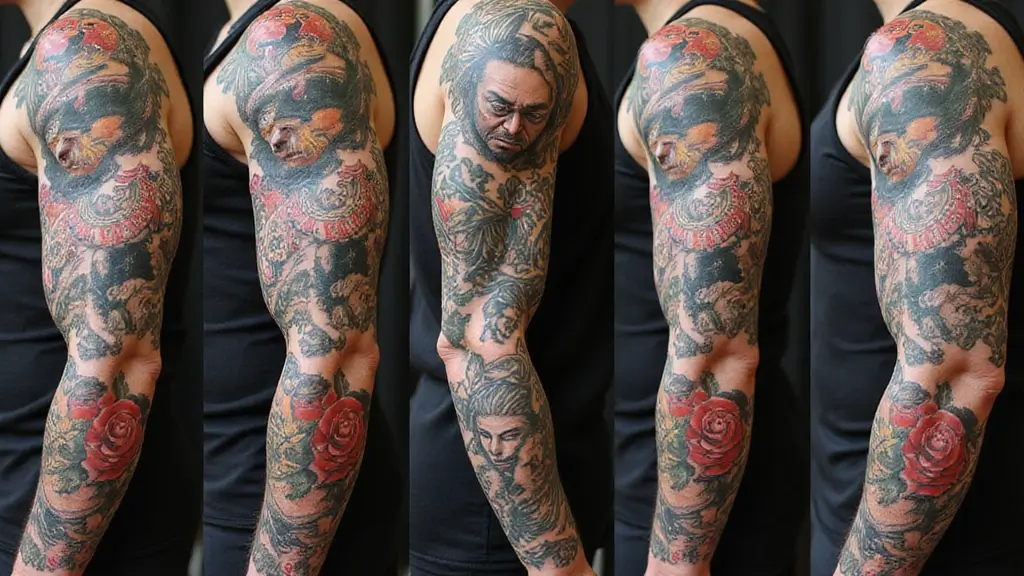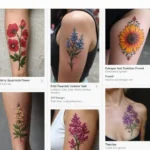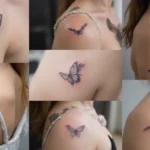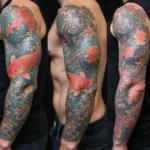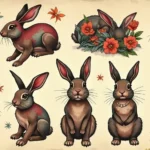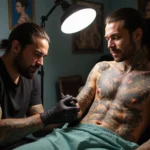I put this together because I keep hearing one question from fans of Yakuza tattoo art: where do these name ideas come from, and what do they mean? Yakuza ink is famous for bold scenes and strong symbols. This post brings together 30 name inspirations with clear meanings in one place. It’s about the stories behind the ink, not just the look.
Who it’s for If you love traditional Japanese tattoo art, if you are choosing a name for a tattoo, or you want to learn why certain words carry weight, this is for you. If you are curious about irezumi and the culture behind the art, you will gain context. This is for artists, collectors, and anyone who wants a meaningful tattoo that honors the symbolism.
What you’ll get Here you will find 30 name inspirations, each paired with a short meaning. There is a line about how the name fits into Yakuza lore or Japanese symbolism. You’ll also get practical tips on how a name might sit in a sleeve or back piece, how it pairs with kanji, and what style helps the meaning pop. Think bold blackwork, soft shading, or clean fine line.
How to use this Start with what matters to you. Match the name to a story you want your tattoo to tell. Ask your artist for mockups. Keep in mind cultural context and respect.
Mindful notes Not every name will fit every person. Read the meanings and choose with care. This post aims to inspire art and respect, not to glamorize crime. If a symbol feels off, skip it and pick another that fits your vibe better.
Next steps Dive in, see which names hit you, and let your design take shape. Tell me which ones resonate in the comments or share your own ideas. If you want more on the symbols behind the ink, I’m keeping the conversation open.
1. 龍 (Ryuu) – The Dragon
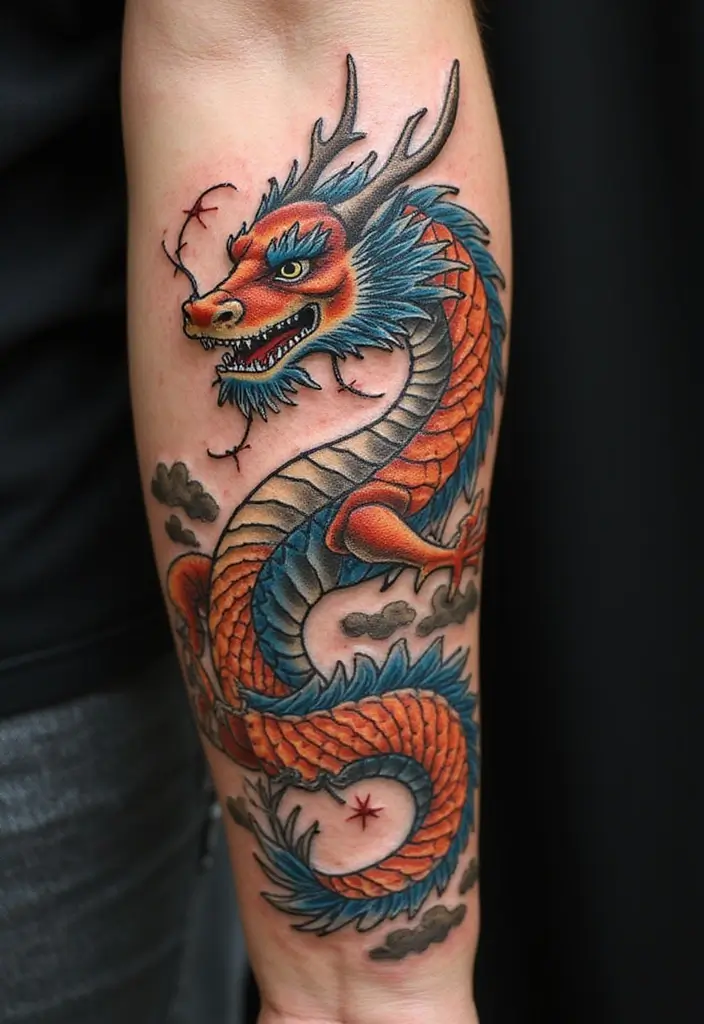
You want a dragon tattoo that stands for strength and wisdom. The Ryuu tattoo shows resilience. In Japanese art, dragons guard the wearer. They symbolize protection and steady will. A Ryuu can curl around the arm, spine, or shoulder. You can picture scales catching light, each scale a sign of a hard-won victory.
Here is why you might choose Ryuu:
– Power and protection. You feel safe when facing a tough day.
– Overcoming challenges. The dragon shows you kept going.
– Flexible styles. You can keep it traditional black ink or add color for life.
– Movement and life. A dragon in motion hints at your ongoing journey.
Practical steps to get it right:
– Decide where the dragon will live on your body. Think about size and pain.
– Pick a style. A classic full-bodied dragon looks bold; a single head with a long tail feels modern.
– Talk with an artist. Bring photos you like and a rough sketch of your story.
– Care and color. Clean lines fade; color needs touch-ups over time.
Limitations to know:
– Dragons can take long sessions. Budget for multiple sittings.
– A big piece will demand aftercare. Follow tips from your artist.
Next steps: research studios, view portfolios, and book a consult.
2. 鶴 (Tsuru) – The Crane
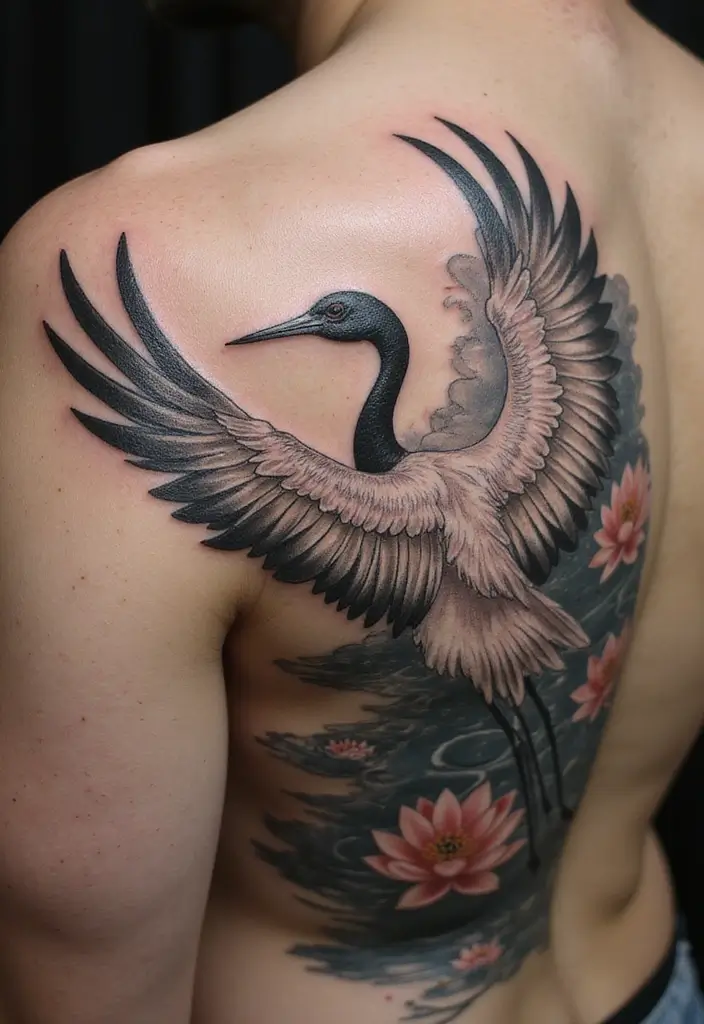
What the Tsuru tattoo stands for
If you want a tattoo that feels calm yet strong, the Tsuru is a smart pick. The crane is a favorite in Japanese art. It stands for longevity and good fortune. It also carries peace and serenity. A crane in flight can show freedom and the pursuit of your dreams. People say cranes live for a thousand years, which adds hope for a long life and prosperity.
Design ideas
– A crane in flight across the shoulder or back to show movement.
– A crane perched on a branch with water or waves beneath it.
– A crane woven with flowers like plum or cherry blossoms for a soft balance.
– A sumi-e style crane with simple, flowing lines for a clean, minimal look.
Color and style
– Black and gray ink gives a classic, bold line work.
– Subtle color works too: red accents, blue water, pale pink blossoms.
– For style, choose traditional Japanese Irezumi for strong panels, or brush-style sumi-e for a lighter feel.
Placement and care
– Good spots include the shoulder, upper arm, back, or chest. A full sleeve or back piece can tell a big story.
– Aftercare is simple: clean gently, keep sun exposure low, and use fragrance-free lotion. Let the skin heal fully before adding more ink.
Next steps
– Bring clear reference photos to your artist.
– Talk through line work to ensure the crane stays crisp and long-lasting.
– Plan the pairing elements, like water or blossoms, to match your life story.
3. 釈迦 (Shaka) – The Buddha
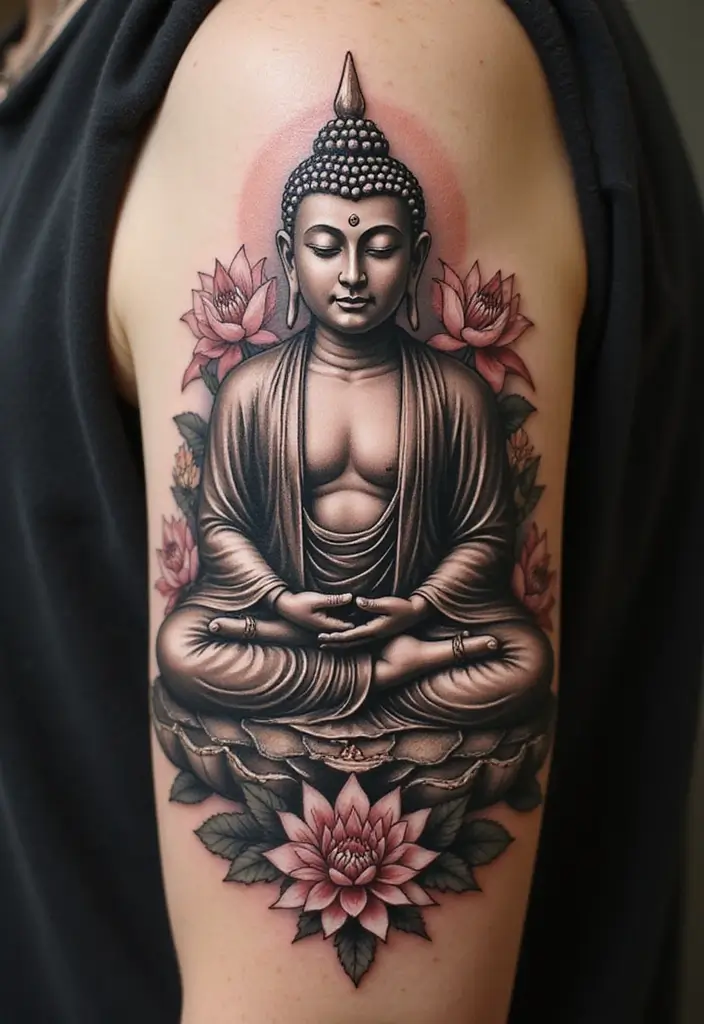
If you want a tattoo that signals inner growth, the Shaka Buddha design fits you well. It blends calm symbolism with a strong personal message.
In Yakuza tradition, the Shaka tattoo marks a path toward self-realization and peace. You might see the Buddha seated in meditation, often with lotus flowers nearby. The lotus stands for purity and rebirth, a sign that your mind can become clear and new with time. This tattoo keeps mindfulness at the center and reminds you to stay steady in tough moments.
What the Shaka tattoo means
– Symbolizes enlightenment, peace, and mindful living
– Lotus flowers add depth and a sense of rebirth
– Represents inner strength and resilience
– A quiet, spiritual design you can wear with pride
Design ideas and styles
– Poses: meditating Buddha, or a gentle seated posture with soft, flowing lines
– Styles: traditional Japanese ink, black and gray, or clean modern color
– Details: subtle shading, a gentle halo, or a single lotus bud for simplicity
– Placement ideas: upper arm, back shoulder, chest, or forearm for easy visibility
Practical steps to plan yours
– Gather reference images of Shaka and lotus motifs
– Decide on a style that fits your skin and budget
– Talk to an artist about line work, shading, and color balance
– Check for respectful, accurate symbolism and avoid crowding the design
Care and realism to know
– Choose skin-safe inks and a reputable shop
– Expect light, clean lines for longevity if you want a timeless look
– Aftercare matters: keep the skin clean and moisturized to hold the details
If you’re drawn to spiritual themes, the Shaka Buddha tattoo offers a clear symbol of your journey toward serenity and awareness.
Embrace the journey of self-realization with a Shaka tattoo. Like the lotus, let your mind blossom anew, reminding you to stay anchored in peace during life’s challenges.
4. 般若 (Hannya) – The Hannya Mask
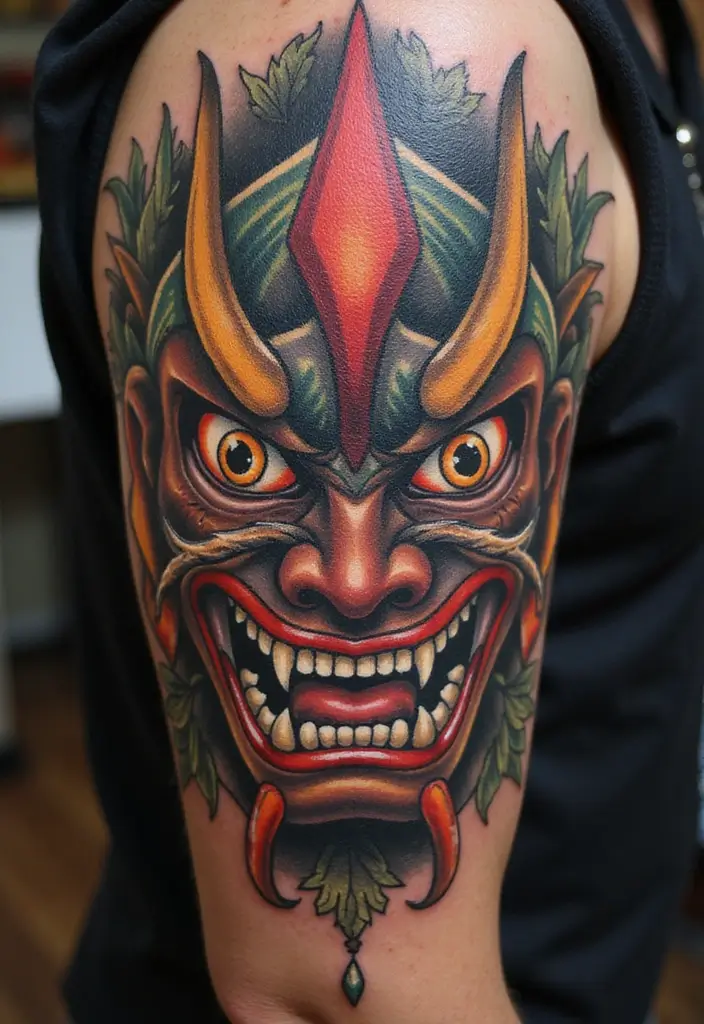
If you want a tattoo that speaks with big emotion and clear meaning, the Hannya mask is a strong pick. It comes from Japanese art and fits a bold, Yakuza-inspired look. The mask shows a woman shaped by intense feelings. It makes a statement with sharp lines and dramatic color.
Here is why it can fit your story. It blends power with protection and invites reflection.
What the Hannya tattoo means
– It shows the pull of strong emotions that go beyond mood and fit a tough story.
– It is often seen as protection against bad luck and evil spirits that follow you.
– It stands for inner strength and the steady will to endure even through pain.
– It captures the idea of duality: pain and beauty, rage and mercy, all in one mask.
– It invites you to grow and own your emotional depth.
Design notes
– Expect intricate line work and bold outlines for big impact.
– Color can be dramatic red with dark shading, or a clean black-gray look.
– The eyes and horns drive the gaze and add real intensity.
– Details age differently over time; plan a size that keeps the features clear as you heal.
Practical tips
– Good spots: shoulder, upper arm, back, or chest gives room to breathe and display the mask.
– Size: aim for at least 6-8 inches to keep details sharp and legible.
– Care: clean daily, moisturize, and shield from strong sun during healing.
– Work with an artist who knows both traditional and modern twists.
Next steps
Bring reference images, ask about stencil placement, and map out a color plan.
5. 牡丹 (Botan) – The Peony
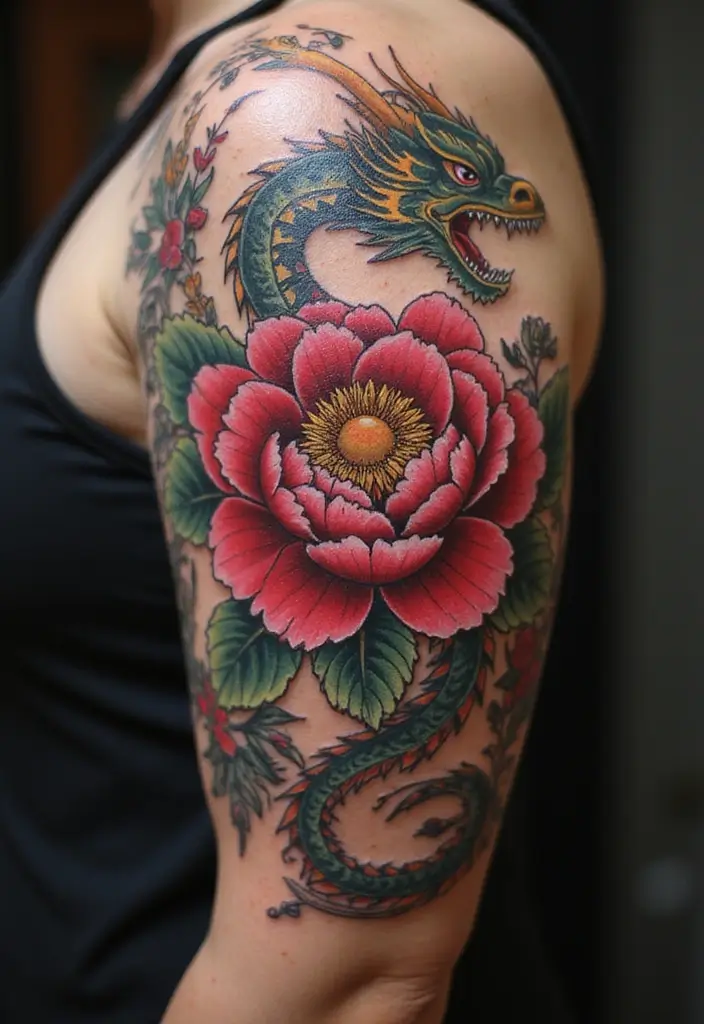
If you want a tattoo with real meaning and a clean look, Botan can fit your plan. Botan is the peony in Japanese art. It stands for prosperity and good luck. A big peony tattoo grabs attention and holds a quiet, powerful story.
In Yakuza tattoos, the peony also shows bravery and strength. It blooms in rough spots, a sign you can rise through hard times. That mix makes Botan a strong choice for a bold, colorful piece that ages well.
Here is why you should consider Botan and how to do it well.
– Prosperity, beauty, bravery: The flower links wealth, charm, and courage in one image.
– Pairing power: Add dragons or koi to give a layered story.
– Bold color appeal: Choose red, pink, or white petals with rich shading.
– Petal detail: Expect intricate lines and many petals that require careful inking.
To get the look you want, plan with a skilled artist who knows Japanese tattoo style. Look for smooth shading, clean outlines, and how petals flow with other symbols. A large piece on the back, shoulder, or chest gives space for depth and color.
Care matters too. Follow aftercare steps, keep sun off the ink, and touch up as needed. Bring photo references of peony petals and dragon or koi ideas to your appointment. Next steps: gather ideas, check portfolios, and book a consultation with a trusted tattoo shop.
6. 鯉 (Koi) – The Koi Fish
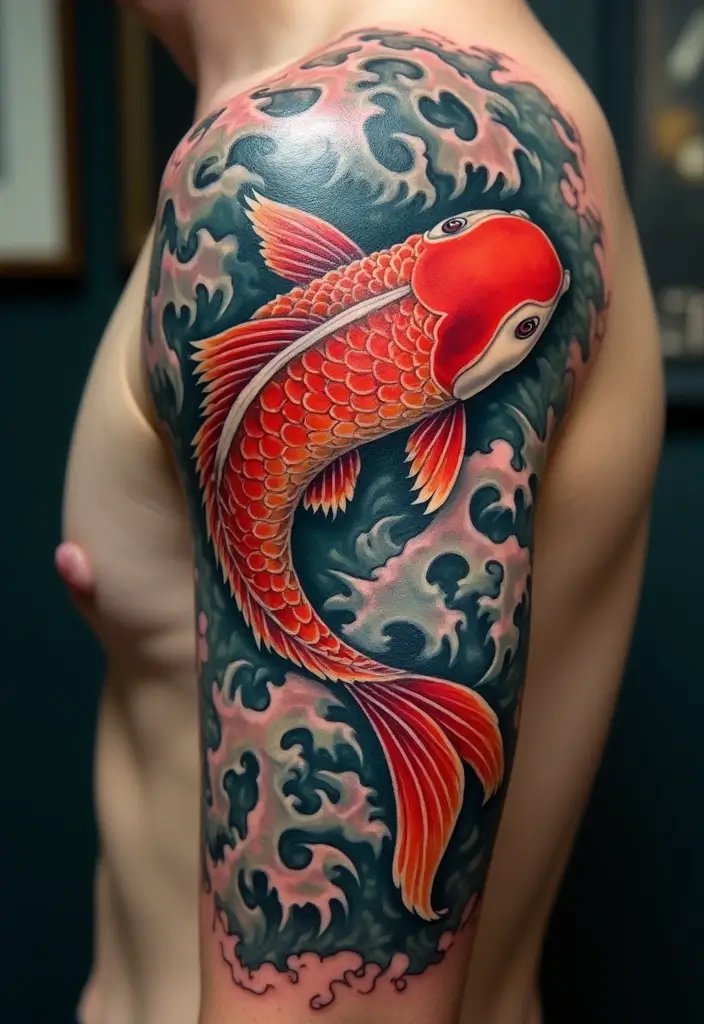
If you want a koi tattoo that shows grit and growth, you are in the right place. The koi swims upstream, fighting the current. In ink, it marks your will to overcome tough times.
– Meaning at a glance Perseverance and strength. It tells your story of pushing through and reaching your goals.
– What the art looks like Bright colors, clean scales, and a sense of momentum. Water elements like waves, splashes, and curling fins add motion.
– Styles to consider Traditional Japanese koi use bold outlines. You can also choose neo-traditional ink or watercolor washes that blend with the skin.
– Color cues Red signals courage, gold hints at luck or wealth, black shows obstacles you have or will overcome. You can mix colors to tell your focus.
– Placement ideas Large pieces on the back or chest feel dramatic. A smaller koi on the arm or calf stays bold. Add a water backdrop to frame the fish.
– Care tips Color stays brighter with good aftercare. Wash gently, pat dry, and use a fragrance-free lotion. Keep the sun away for the first weeks.
Next steps
– Collect a few reference images that match your vibe.
– Talk with your artist about line work and shading plans.
– Try a temporary version first to see how it looks on your body.
– Follow simple aftercare: keep ink clean, moisturize, and avoid sun for the first weeks.
| Tattoo Name | Meaning | Design Ideas | Placement | Care Tips |
|---|---|---|---|---|
| 龍 (Ryuu) | Strength and wisdom | Dragon curling around arm or spine | Arm, spine, shoulder | Clean lines, moisturize, avoid sun |
| 鶴 (Tsuru) | Longevity and good fortune | Crane in flight or perched | Shoulder, upper arm, back | Gentle cleaning, low sun exposure |
| 釈迦 (Shaka) | Inner growth and peace | Meditating Buddha with lotus | Upper arm, back shoulder, chest | Use skin-safe inks, keep clean |
| 般若 (Hannya) | Emotional depth and protection | Intricate mask with bold outlines | Shoulder, upper arm, back | Daily cleaning, moisturize, shield from sun |
| 牡丹 (Botan) | Prosperity and bravery | Large peony with dragons or koi | Back, shoulder, chest | Follow aftercare, protect from sun |
7. 幸運 (Kouun) – Good Luck
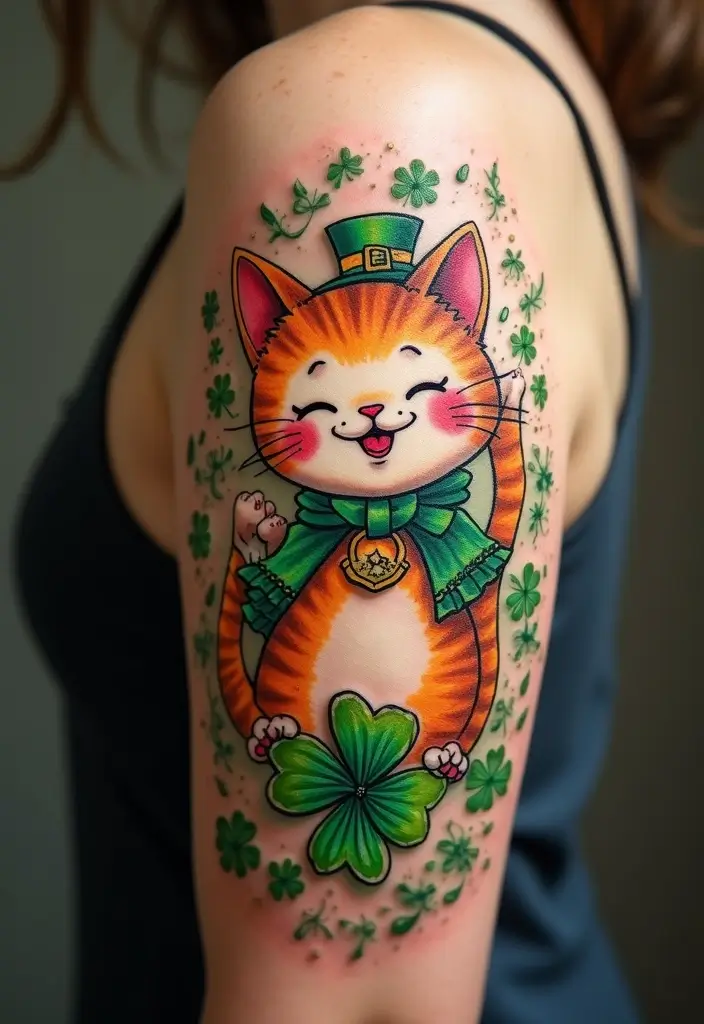
If you want a tattoo that invites good luck, Kouun is a strong choice. Kouun means good fortune in Japanese, and it can feel like a personal charm you wear every day.
What Kouun expresses
Kouun tattoos symbolize hope, positive vibes, and a bright outlook for the future. They’re more than just a design; they’re a little reminder that luck can come with effort and patience. You can keep the look simple or let it grow into a richer scene.
Lucky symbols to consider
– Maneki-neko, the lucky cat that seems to wave hello and invite good fortune.
– A four-leaf clover, a universal sign of luck that also looks clean in ink.
– A crane or a koi, symbols of longevity, resilience, and steady progress.
– A small lucky coin, a simple nod to fortune and chance.
Design options
Keep it clean with sharp black lines for a minimalist Kouun. Add shading for depth, or go bold with color to lift the mood. For a true Japanese feel, you can weave in waves, clouds, or wind bars around the main symbol. Here is why this matters: the style sets the energy of the tattoo, not just its look.
Placement and scale
A small Kouun works on the wrist, behind the ear, or on the ankle. A larger piece can sit on the shoulder, forearm, or calf and tell a longer story of luck and growth. Start with a focal symbol, then add supporting elements if you want.
Getting started
– Step 1: pick a symbol that truly resonates with you.
– Step 2: decide if you want a simple line work piece or a richer, colored design.
– Step 3: choose an artist who understands clean lines or traditional Japanese style.
Next steps: bring your ideas to a consult, ask to see stencil sketches, and talk about aftercare plans.
Care and longevity
Follow your artist’s aftercare routine. Keep the tattoo clean and moisturized. Protect it from direct sun during healing, then use sunscreen to keep colors bright over time.
8. 結び (Musubi) – Ties
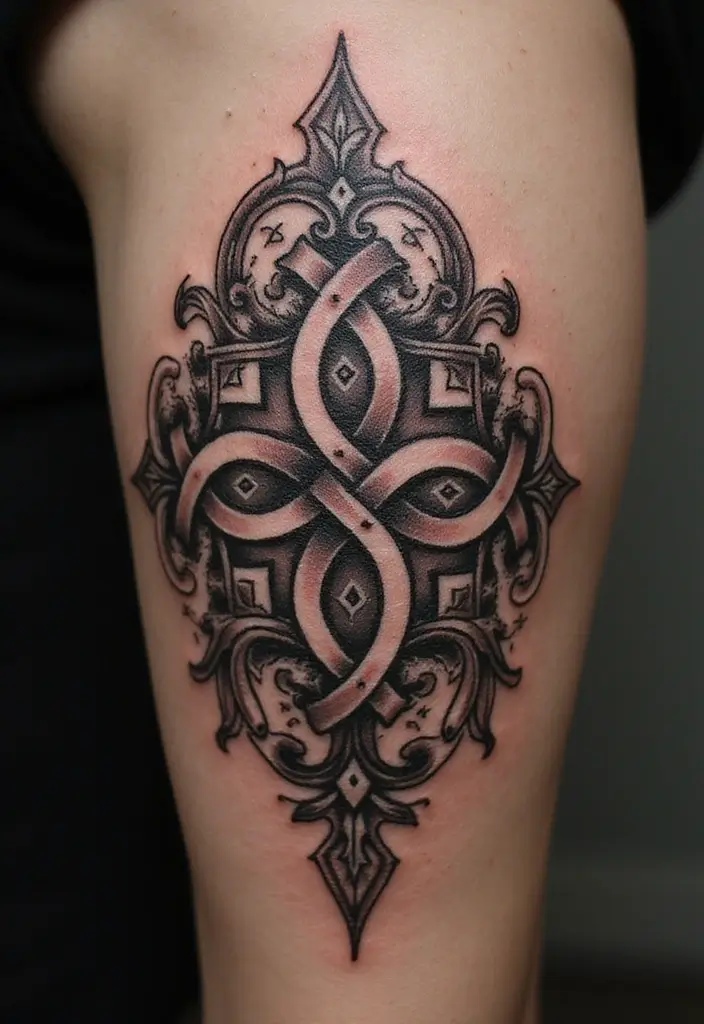
Want a tattoo that signals who you keep close? Musubi can do that. Musubi is a knot that shows bonds. In Yakuza tattoo art, it stands for loyalty and kinship. You can wear it as a simple loop or a braided pattern. Either way, it reminds you of your people every day.
– Represents connections and loyalty
– Uses interlaced patterns to show bonds
– Ideal for those who value family and close friends
– Carries personal meaning in the design
Here is why Musubi works in tattoo art. It fits different sizes and spots. Put it on the wrist for a quick sign, or on the chest near the heart for a deeper message. You can keep it minimal with one line or add texture with a braided knot.
Placement ideas
– Wrist or forearm for visibility
– Chest near the heart for intimacy
– Shoulder for a larger statement
Design options
– Minimal single-line Musubi
– Interlaced knot or braided loop
– Black ink with light shading for depth
Practical steps
– Gather knot references you like
– Define what your bond means to you
– Talk with your artist about line work, size, and shading
Next steps: bring your story to the shop, compare sketches, and choose a clean, lasting look.
9. 風 (Kaze) – The Wind
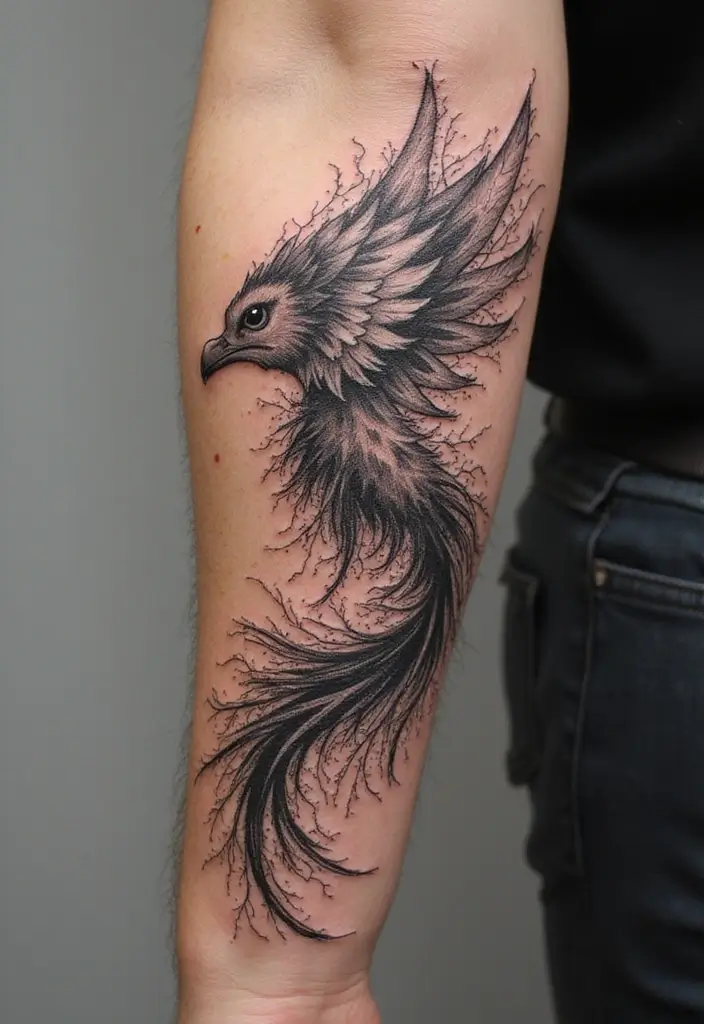
You want a tattoo name that fits a life of ups and downs. Kaze speaks to that in a clear way. Wind is a sign of change. It also stands for freedom of movement. In Japanese tattoo art, wind motifs mirror life in motion. With Kaze, you show you go with the air, not against it.
Here is why it works:
– It marks adaptability and grit
– It keeps focus on moving forward
– It looks good as flowing lines or abstract gusts
– It fits many places, from wrist to shoulder
Design ideas and tips:
– Favor long, curving lines that sweep around your arm or leg
– Add wisps that fade to show a breeze fading away
– Pair wind with small symbols like clouds or leaves for extra meaning
– Keep colors simple: black ink with light gray shading; you can add a subtle blue accent if you want
Practical steps for getting a Kaze tattoo:
– Talk with your artist about line weight and how the wind will flow on your skin
– Ask to map the design from a starting point to a natural ending point
– Use clean, solid black for the main gusts and soft shading for depth
– Aftercare: keep the skin clean and moisturized; avoid sun while it heals
Next steps:
decide where wind feels most alive on your body, then sketch ideas that let the lines wrap and breathe as you move. If you resonate with themes of change and freedom, a Kaze tattoo can be a meaningful choice. Take your time with the sketch and let the wind guide the line work.
10. 太陽 (Taiyou) – The Sun
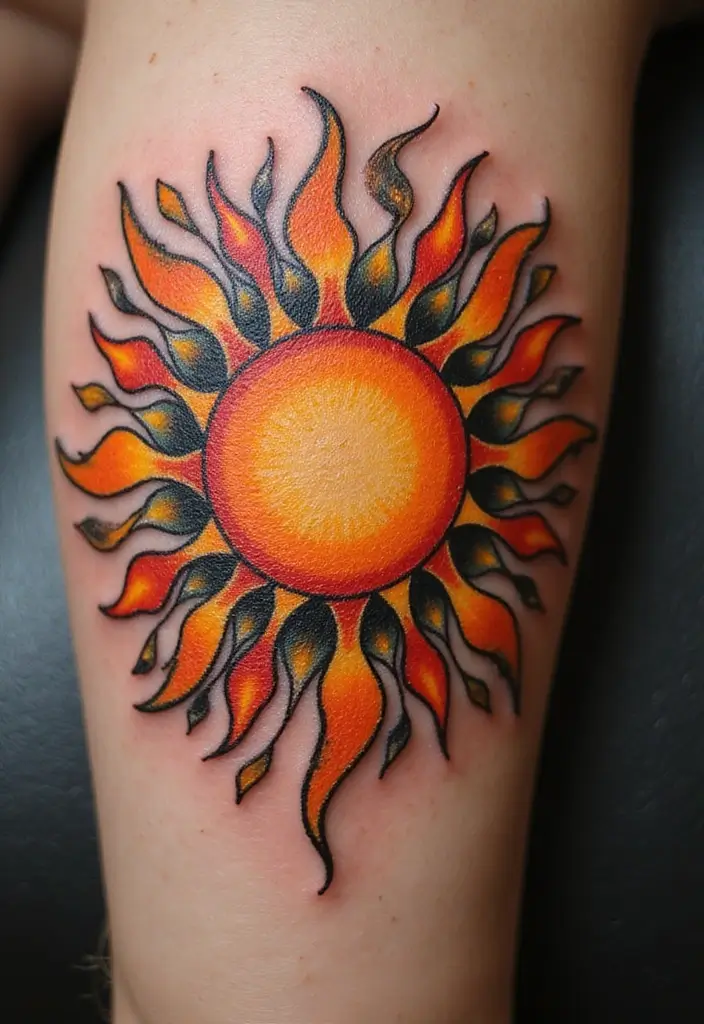
Taiyou: The Sun Tattoo Name Guide
You want a sun tattoo name that fits a yakuza look and carries real meaning. Taiyou, the sun, stands for life force, growth, and direction. A Taiyou tattoo can remind you to keep going and to start fresh after big changes. It also points to clear thinking and the path you want to take.
Design ideas
– Use bold sun rays and warm colors like red, gold, and amber.
– Let the kanji 太陽 be the main mark or pair it with a script that reads Taiyou.
– Try brush-style lines for a classic feel or block letters for a strong, modern look.
Practical notes
– Decide if you want kanji, romaji, or a mix in your tattoo name.
– Work with your artist on a stencil that fits your body part.
Placement and care
– Common spots include the forearm, chest, or shoulder blade.
– Bold lines age better; ask for thicker outlines and simple shading.
– Aftercare means keep it clean, out of direct sun, and moisturized.
Next steps
– Here is why it helps: it keeps your personal growth in sight and links to the sun’s energy.
– Here is how you start: gather 太陽 references, pick a reading, and book a consult.
11. 鳳凰 (Houou) – The Phoenix
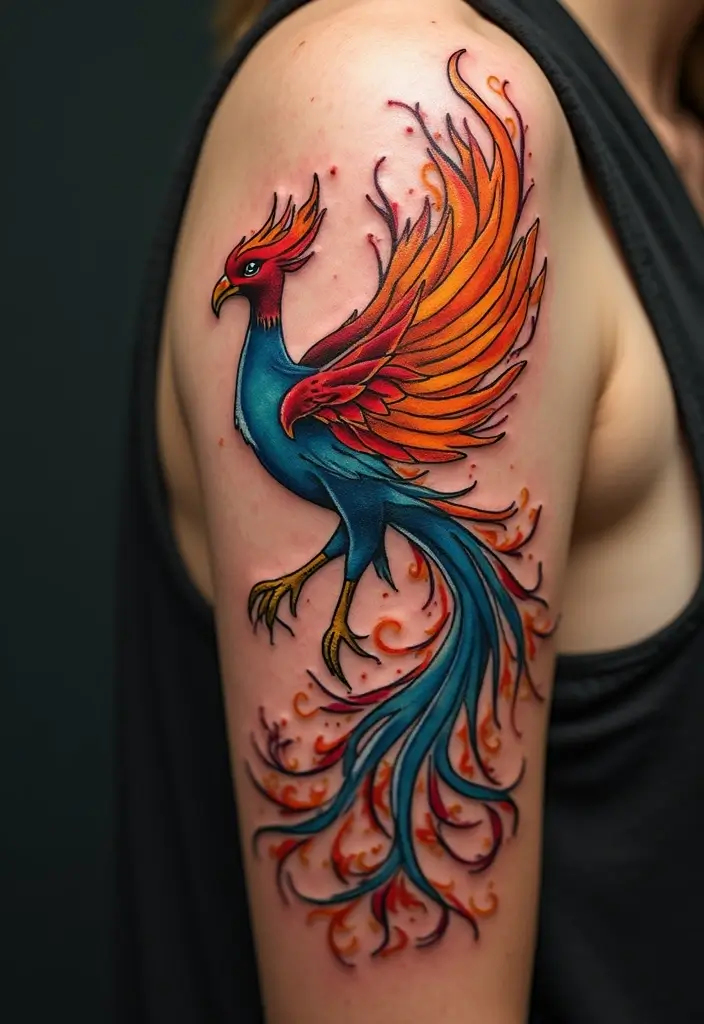
If you want a tattoo that marks a personal turning point, the Houou, or phoenix, is a top pick for a Yakuza sleeve or back piece.
Meaning you carry
– The Houou stands for rebirth and renewal.
– It shows you rose from hard times and kept your truth.
– It celebrates growth and the cycles of life.
– It says you faced pain and came out stronger.
Design and style
– Designs use bright flames wrapping around the bird.
– Expect bold outlines with smooth shading.
– Colors often include red, orange, gold.
Where it fits on your body
– Back, chest, shoulder, or sleeve work well.
– A Houou can be the centerpiece or pair with waves, koi, or clouds.
How to plan it
– Bring a few reference images of the Houou and flame style you like.
– Decide on a color plan and line weight before you sit for ink.
– Talk with your artist about the pose and sizing to fit your skin and movement.
Care and longevity
– Keep it clean while it heals.
– Use moisturizer and shield it from strong sun.
– Good needle work and proper aftercare help your colors stay bright.
Next steps
– Ready to plan your Houou tattoo? Schedule a consult and ask for a mockup that shows how it will look on your body.
If you prefer a calmer look, ask for softer shading and subtler flames.
12. 妖怪 (Youkai) – The Yokai
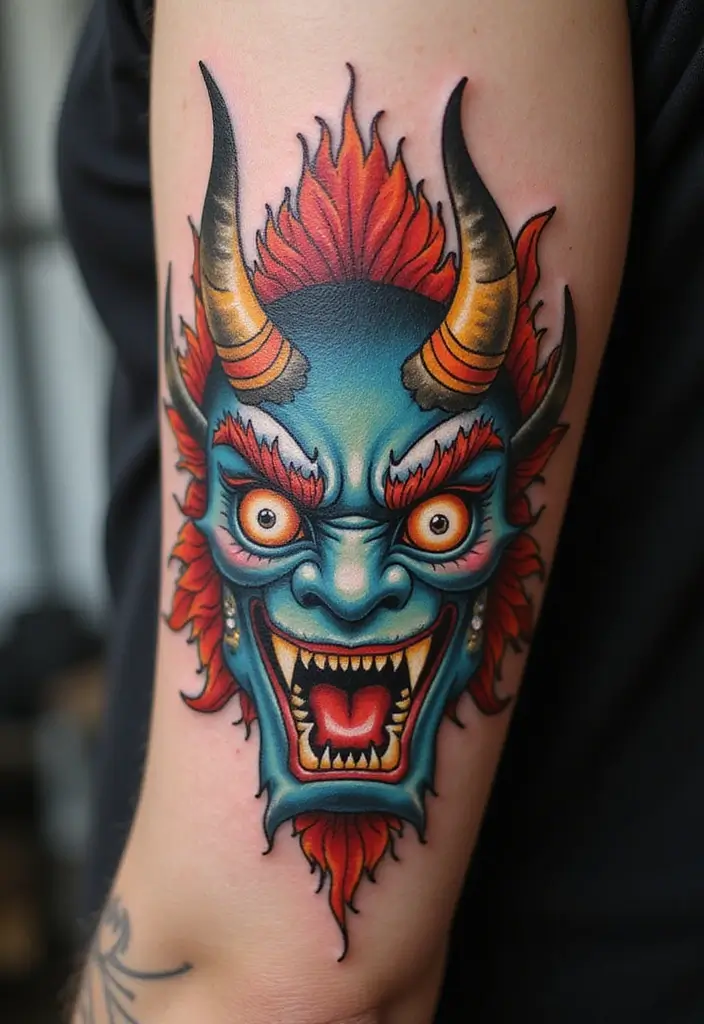
If you want a tattoo with mystery and depth, a Youkai design fits. Youkai are spirits and monsters from Japanese folklore. They show traits that live in all of us, sometimes kind, sometimes fierce. A Youkai tattoo reminds you that life holds both light and dark.
In Yakuza art, a Youkai piece shows the self as it is. You accept all parts of you, not just the clean ones. Designs range from playful to fearsome. You may see bright colors, bold lines, and strange faces that feel alive. Look for an artist who studies Japanese tattooing and can do clean, strong lines.
Here’s why a Youkai tattoo works. It carries quiet strength. It invites talk about what you hide and what you show.
– Represents the duality of human nature
– Can be whimsical or fearsome
– Shows your complex side
– Uses rich colors and detailed artwork
Next steps to plan your Youkai tattoo:
– Decide the vibe you want: light and funny or dark and dramatic
– Pick a color plan: bright hues or deep shadows
– Choose placement: sleeve, back, or chest for big impact
– Find an artist who handles Nihon style: strong line work
– Pair with other motifs: waves, dragons, or blossoms
Care tips: wash gently, keep it moisturized, shield from sun.
Your Yokai tattoo can grow with you as your story changes.
13. 亀 (Kame) – The Turtle
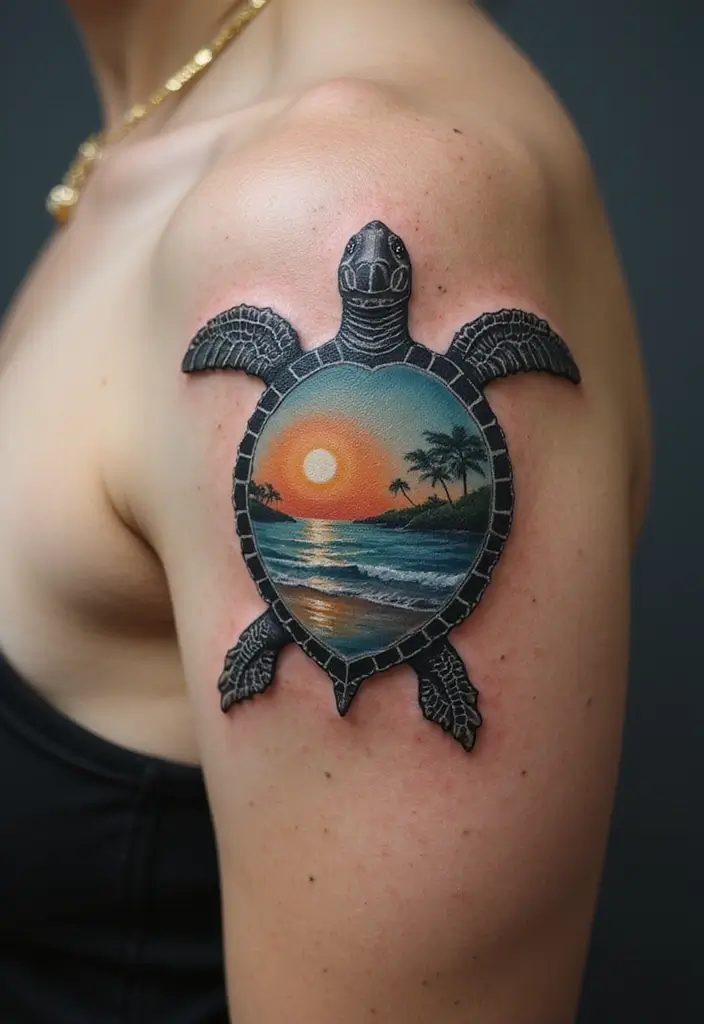
Are you after a tattoo that lasts and feels grounded? A Kame, the turtle, can be your answer. In Japanese art, the turtle stands for longevity, stability, and patience. A Kame tattoo often carries wisdom you wear on your skin.
Here is why a turtle fits in Yakuza style ink. The lines stay calm, the shading stays soft, and the image ages well. The creature’s slow path through life mirrors your own patient path. That makes it easy to live with.
– Meaning: longevity, stability, patience
– Style: serene lines, calm shading, quiet power
– Message: the journey through life, grounded choices
– Who it suits: you who seek wisdom and self‑control
Design ideas
– A turtle gliding through water or resting on a rock
– Ocean waves, koi, or lotus to add depth
– Traditional Japanese ink: bold outlines with controlled color
– Color choices that age well: black and gray for a timeless look, or restrained hues for a softer vibe
Next steps
– Find artists who specialize in irezumi or sumi-e styles
– Check portfolios, ask about stencil, skin tone, and aftercare
– Talk about placement, size, and maintenance to keep the look strong
It ages with you.
14. 雪 (Yuki) – The Snow
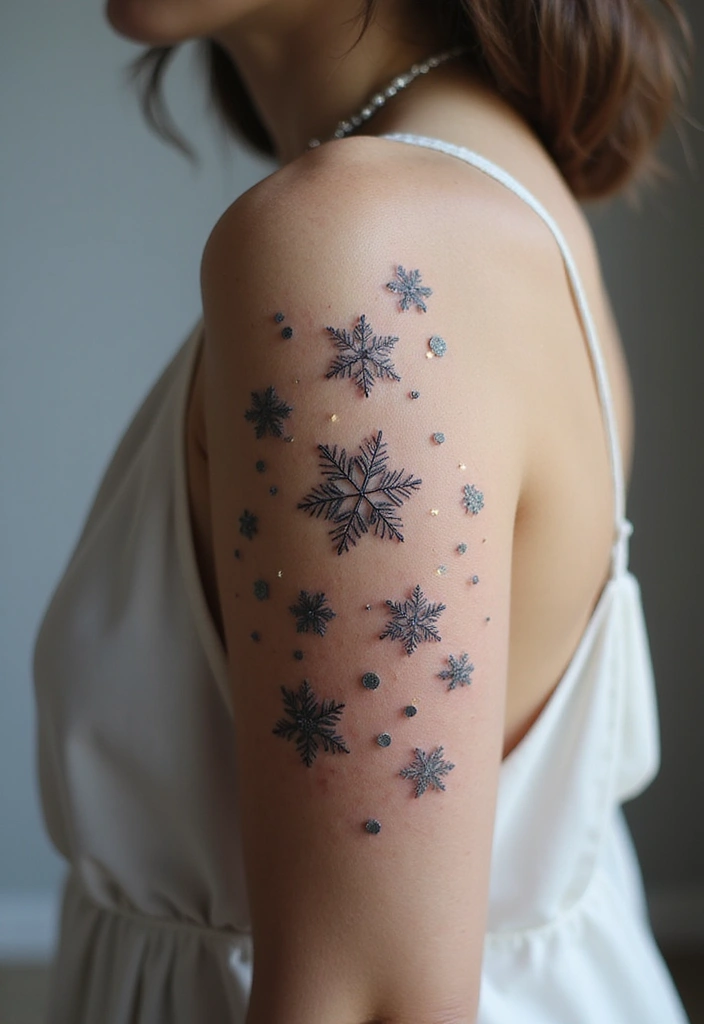
You want a tattoo that feels calm and pure. Yuki, or snow, gives you that. In Japanese art, snow stands for purity and quiet balance. A Yuki tattoo can be a soft reminder to slow down, breathe, and stay in the moment. Snow also shows how things change—how beauty can fade and still shine in memory. In traditional tattoo lore, Yuki designs honor simple, clean lines and the power of a single moment.
– Meaning you can carry: purity and tranquility
– Visual ideas: snowflakes, winter landscapes, bare branches, a soft frost
– Styles to consider: minimalist linework, black and gray shading, a blue‑tinted wash, or subtle dot work
– Message you send: celebrate simplicity and balance in life
Here is why this design fits you. Snow designs feel graceful and unfussy. They work well in small, intimate places or as a sweeping scene on the back or forearm. They pair nicely with other symbols, like pine trees or distant mountains, to tell a personal story.
Next steps to bring your Yuki tattoo to life.
– Pick two or three elements you love most (a flake, a branch, a quiet hill).
– Decide on a size and place that fits your daily life and work rules.
– Find an artist who can map crisp lines with soft shading for a calm, lasting look.
– Choose monochrome or a light blue tint for a chilly, winter feel.
Tips for care and staying sharp. Use clean skin after healing, protect from harsh sun, and moisturize. A well done snow tattoo ages gracefully with steady, careful care.
15. 月 (Tsuki) – The Moon
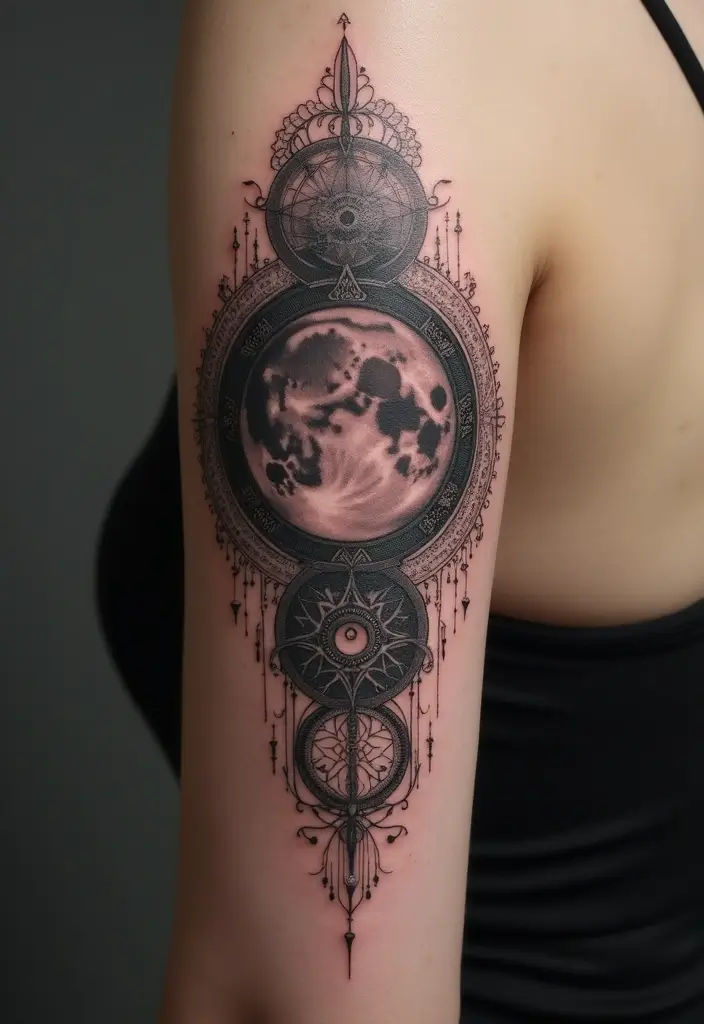
– Tsuki and you You want a tattoo that speaks to your inner life. Tsuki, the Moon, fits. It carries calm and curiosity. It invites you to listen to your thoughts. In Japanese, 月 is read Tsuki and means the Moon.
– What Tsuki stands for It stands for intuition and reflection. It asks you to pause before you act. It hints at mystery that invites wonder. A Tsuki tattoo can feel like a quiet guide on your skin, too.
– Design ideas you can try A crescent or full moon is classic. Add lunar phases in a line to show change over time. Use clean lines for a modern look or dots for texture. A single moon keeps it simple yet strong.
– Placement and style tips The forearm keeps the Moon in view daily. The shoulder or chest gives a private vibe. For a soft look, use fine line work. For depth, add subtle shading.
– What to tell your artist Explain that Tsuki means inner discovery. Bring moon phase references you like. Talk about size, line weight, and how you want it to feel as you grow.
– Next steps Gather moon images, sketch ideas, or print references. Book a consult. Trust your gut about the final design. A Tsuki tattoo can remind you to reflect and grow daily.
16. 笑顔 (Egao) – Smile
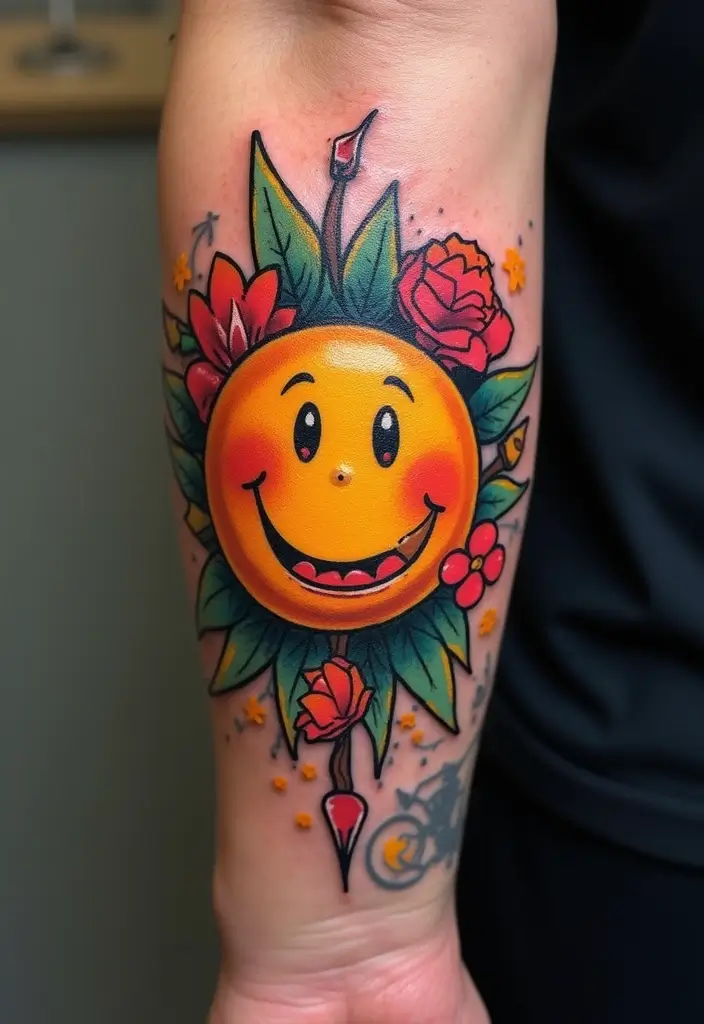
Are you seeking a tattoo that acts like a daily cheerleader? Egao is the Japanese word for smile. In Yakuza tattoo art, a smile stands for happiness and a positive outlook. The design can feel playful and bright, with clean lines and confident color. You wear it on your skin, so it should invite light and warmth, not heaviness. Let it remind you to find joy in small moments.
Here is why this choice works for you:
– Represents happiness and positivity
– Often done in bright, playful styles
– A joyful reminder you see every day
– Helps lift your mood when you catch your reflection
Design ideas
– Clean line work with a small curved smile
– A full face with friendly eyes and a gentle grin
– A smiling sun or orb paired with the word Egao
– Simple, bold colors or a soft black-and-gray approach
Next steps to plan
– Decide the size and place, like the wrist or forearm
– Pick a color plan: yellows and pinks, or black ink
– Talk with your artist about soft shading and smooth edges
– Bring sample photos to show the vibe you want
Care tips
– Follow aftercare for best healing
– Keep the area clean and moisturized as it heals
– Protect from direct sun in the first months
End note
– This design fits many styles and keeps a friendly, sunny mood on your skin.
A smile is a powerful tattoo – it invites joy and positivity wherever you go. Embrace the essence of 笑顔 (Egao) and let your ink remind you to cherish every small moment of happiness!
17. 星 (Hoshi) – The Stars
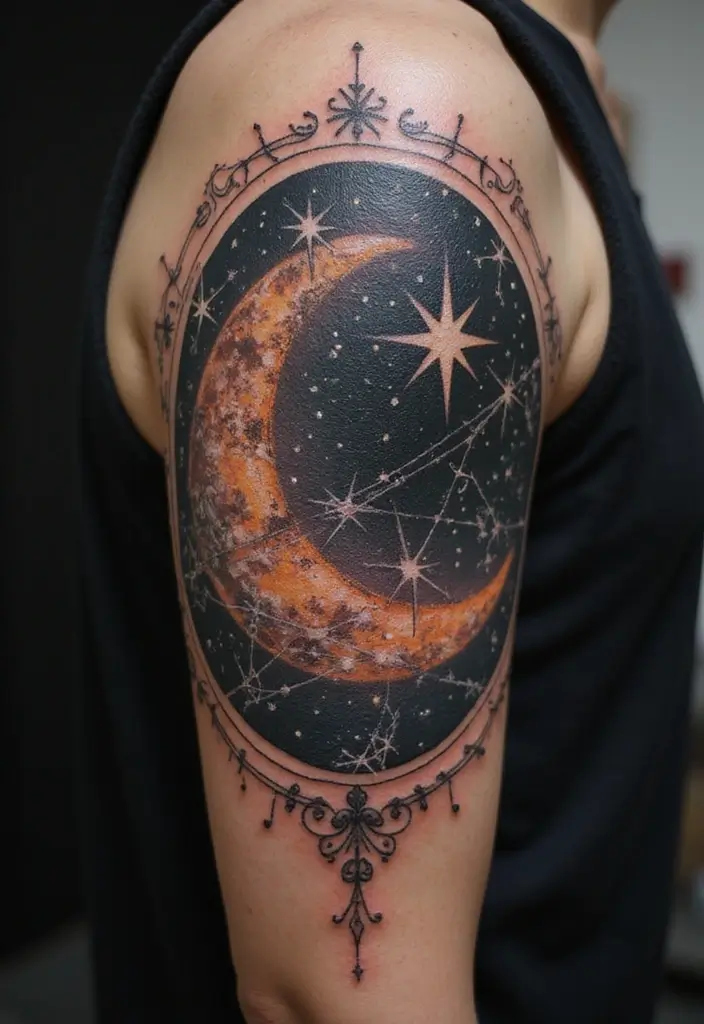
What the Hoshi (The Stars) tattoo means
You want a symbol of hope and a clear path forward. The star, or Hoshi, fits. It shows direction and dreams. It lights your way when roads are dark.
– Represents aspiration, hope, and guidance
– Often uses simple stars, clusters, or shooting stars
– Fits anyone chasing a goal or fresh start
– Reminds you of your journey
Design ideas to try
Pick a look that suits your life story. A single star gives focus. A small constellation maps your path. A shooting star marks a turning point. Mix styles like clean line work or dot shading for depth.
In Yakuza culture, a star tattoo keeps you rooted. It says you stay true to your path and walk with purpose.
Where to place it
Decide on size by the area you want. A wrist or forearm stays visible. A shoulder or back can hide it or reveal it. Choose color carefully: black ink lasts, color adds life in small pops.
Care and trends
Follow basic aftercare to keep lines sharp. Avoid rubbing or peeling skin during healing. Expect lines to age; plan for a touch-up later if you want crisper edges.
Next steps: sketch ideas, talk with an artist about line weight and shading, and study star designs that match your vibe.
A Yakuza tattoo name like Hoshi (The Stars) serves as a beacon of hope. Every star represents your journey—guiding you toward dreams and fresh starts, lighting the path when the road gets dark.
18. 花 (Hana) – The Flower
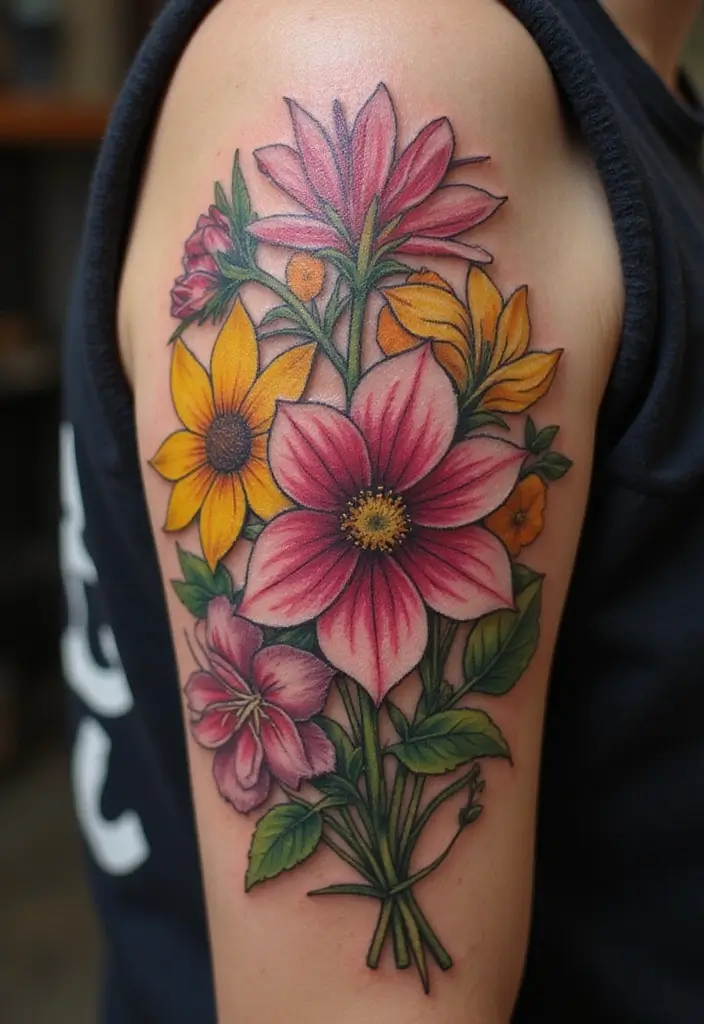
花 (Hana) – The Flower
If you want a Hana tattoo that speaks to growth, you are in the right spot. 花 means flower in Japanese, but the symbol runs deeper. It stands for beauty and the brief, bright life of every moment. In Yakuza ink, a flower shows impermanence and inner strength.
Here is why Hana matters to you:
– Represents beauty and the fleeting nature of life
– You can choose many flower types, each with its own meaning
– It fits anyone going through growth and change
– It nudges you to savor small moments
How to make Hana work for your design:
– Pick a flower that matches your goal: cherry blossoms for renewal; lotus for spiritual growth; camellia for resilience; lily for new starts
– Add leaves or a water element to show motion and life
– Decide on color or keep bold black ink for a classic look
– Start small; you can add detail later
Placement and style ideas:
– Forearm, shoulder, collarbone, or ankle suit Hana
– Traditional Japanese style uses bold outlines; minimalist lines add a modern touch
Next steps:
– Bring reference images and talk with your artist about size, shading, and color
– Plan a design that ages well so the petals stay bright over time
19. 忍者 (Ninja) – The Ninja
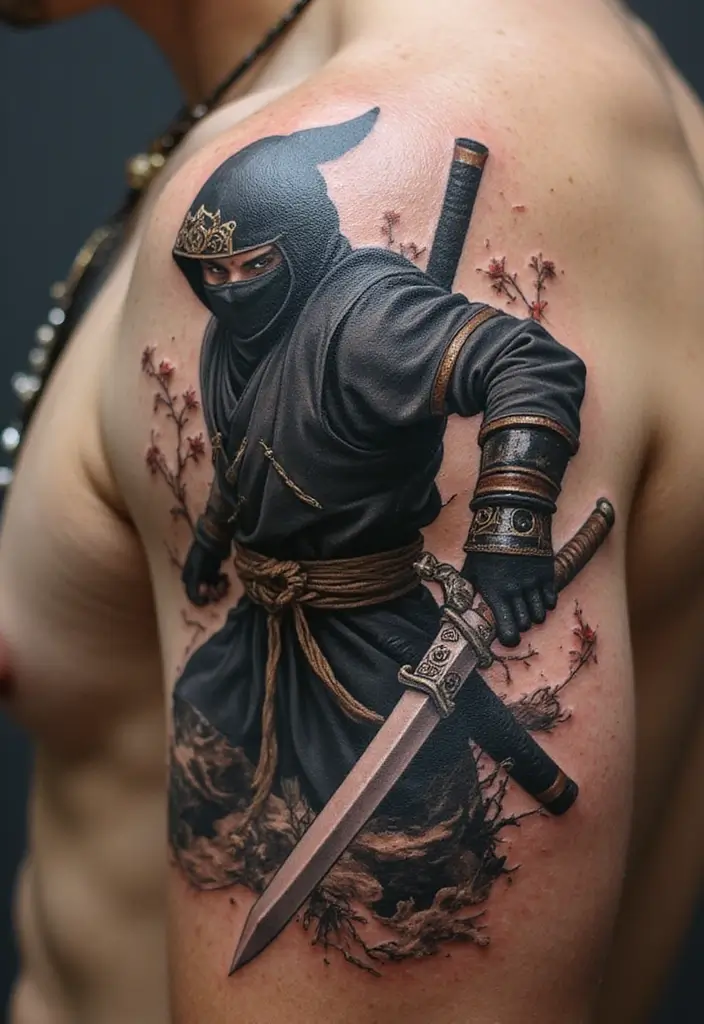
You want a tattoo that speaks of skill and secrecy. The Ninja design fits that goal. It echoes stealth and fast moves. You can wear it as a quiet signal of what you can do.
Meaning of the Ninja tattoo
– Represents stealth, agility, and hidden strength
– Often shown in mid-leap, crouch, or ready stance
– Works well for those who value skill and subtlety
– Reminds you of your inner abilities
Design tips
Choose a style that fits you. Line art, black and gray, or a restrained splash of color can all work. Details matter. Fine lines bring out a mask, robes, and gear. Pose ideas include a ninja in mid-leap, slipping from a shadow, or catching a shuriken in motion. Keep the palette muted. A small red accent can draw the eye without shouting. For placement, think forearm for visibility, or shoulder and back if you want more concealment. Make it yours by mixing styles.
Getting it done
Find an artist who can do clean line work and crisp shading. Look at their ninja tattoos in the gallery. Ask for a stencil test to see how it sits on your skin. Prep the skin well: sleep, drink water, and avoid alcohol before the session. Aftercare matters. Wash gently, moisturize, and shield the tattoo from strong sun during healing.
Here is why this choice fits you. Next steps: talk to artists, review portfolios, and plan a design that stays sharp for years.
20. 影 (Kage) – The Shadow
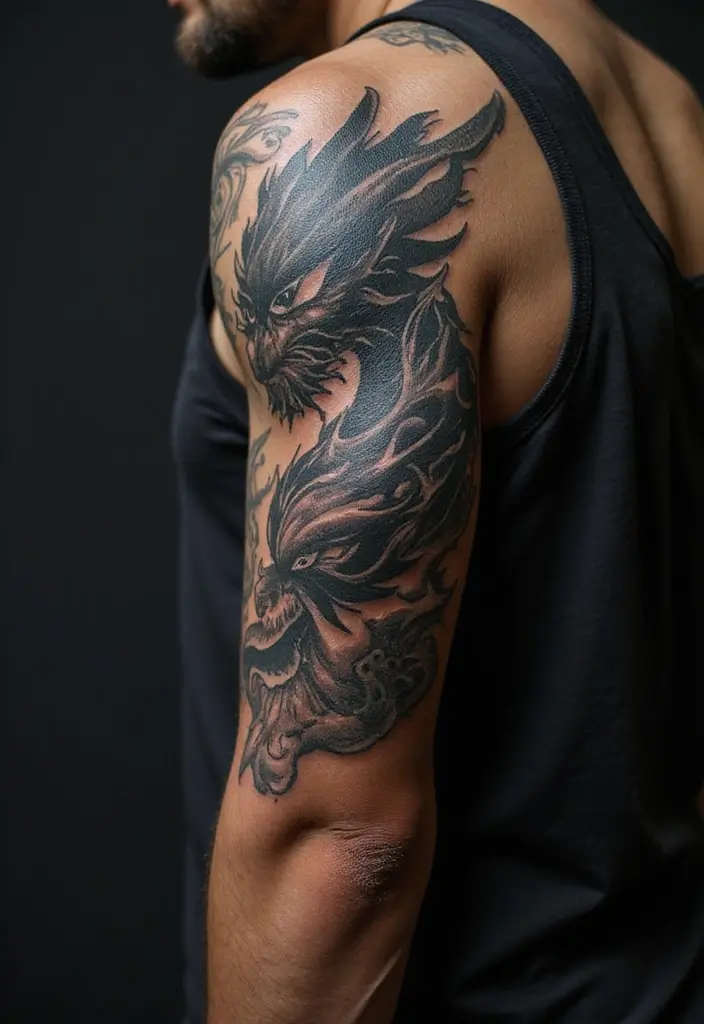
20. 影 (Kage) – The Shadow
You want a tattoo that shows your hidden side. Kage means shadow. It stands for parts you keep in the dark and parts you share in light. In Yakuza art, a Kage tattoo reminds you to accept every part of yourself. It marks the balance between light and dark inside you.
– Hidden aspects of the self
– The balance of light and dark
– A nudge to accept all facets
– Designs that use strong contrast for impact
Here is why this works. It uses bold blacks with soft grays to create a living shadow. You’ll see it in blackwork, gray wash, or fine line styles that play with shade. Some designs use negative space so light can peek through.
Next steps to plan yours:
– Decide size and placement. Forearm, chest, or shoulder fit a Kage theme.
– Bring a few references. Tell the artist how the light should bend and how the dark holds form.
– Think about aging. Thick blacks last longer; thin lines can blur. Ask for a mix that stays clear.
Care and upkeep:
– Follow aftercare exactly. Keep ink clean and out of strong sun.
– Moisturize as the skin heals. Avoid sun until fully sealed.
21. 信仰 (Shinkou) – Faith
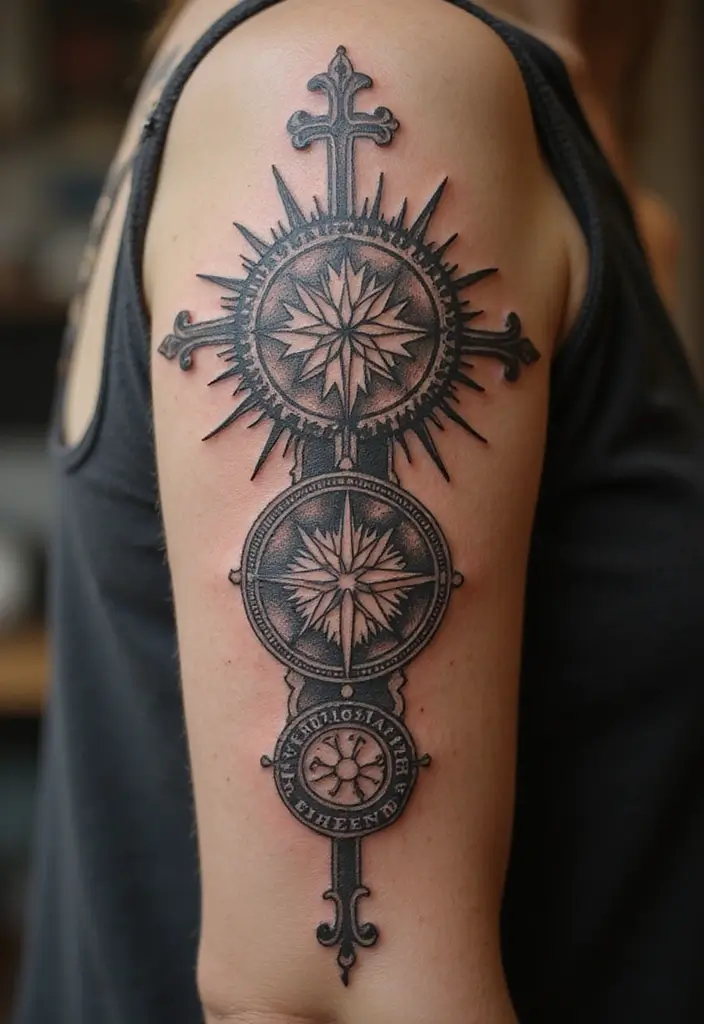
Shinkou meaning and vibe
If you want a Yakuza style tattoo that centers faith, Shinkou is a strong choice. Shinkou means faith, belief, and spiritual devotion. In Yakuza ink, this design shows your connection to your beliefs or a higher power. The look can be bold or subtle, depending on your path. It acts as a daily reminder to stay grounded when life tests you. You can wear it with quiet pride or let it stand beside other strong symbols.
Key takeaways
– Represents faith and spiritual belief.
– Often includes symbols of devotion, like crosses or sacred motifs.
– Ideal for those who value their beliefs and want a personal reminder.
– Serves as a steady anchor, showing the strength faith can provide.
Planning your Shinkou tattoo
Here is how to bring this symbol to life with care and clarity. Start with symbols that speak to you. For example, a cross, a sacred heart, or a motif from your faith. Consider where you want to place it. A chest or back piece catches the eye; forearm keeps it close. Choose a style that fits your other Yakuza ink, such as traditional linework, black and gray, or subtle color accents. Talk with your artist about line weight and shading so the design stays crisp over time. Finally, plan your sessions and healing time. Faith tattoos can be simple or layered with other images, but keep your goals clear. A thoughtful plan helps your Shinkou ink stay meaningful for years.
22. 音楽 (Ongaku) – Music
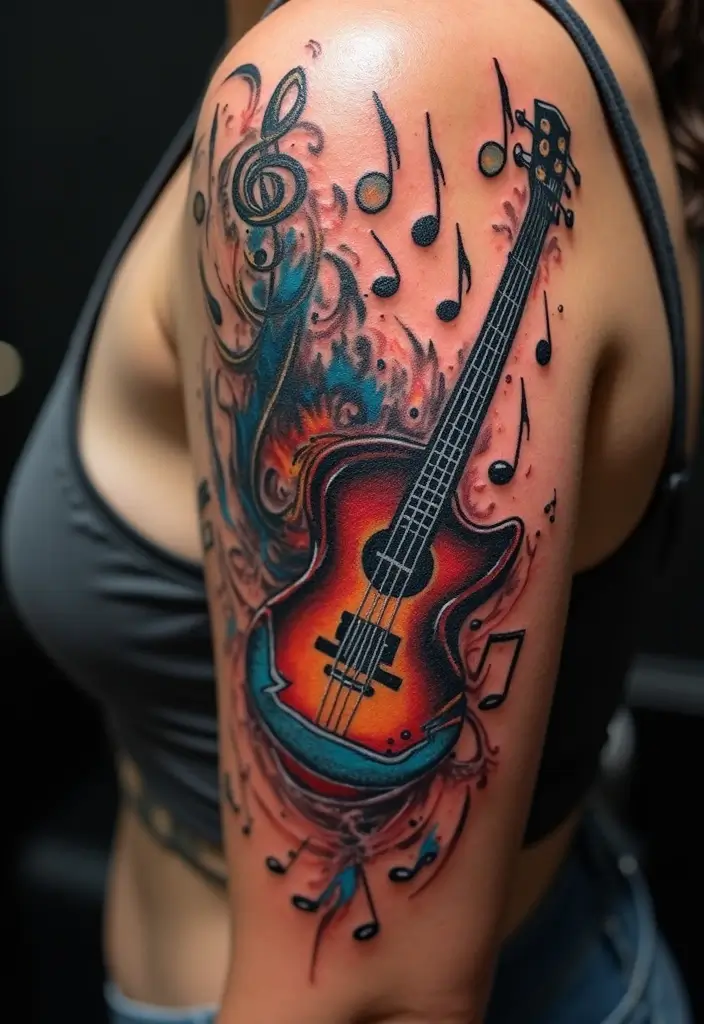
Ongaku: A Music Tattoo That Speaks
You want a tattoo that speaks to your love of music. Ongaku means music, and it carries the feeling you get when a song moves you. In Japanese, 音楽 is the word for music.
In Yakuza art, Ongaku shows how music shapes who you are. It can remind you of a joyful moment, or mark your path as a creator.
Design ideas
– Musical notes, staff lines, or instruments can fill the design.
– A treble clef or guitar silhouette points to your beat.
– Color hints show mood from blues to reds.
– It fits the forearm, chest, back, or ankle.
Make It Yours: A Simple Plan
– Name the song or moment you honor.
– Pick a style: clean lines or shading for depth.
– Pair notes with an instrument or add initials.
– Ask about size and placement in advance.
Placement and care
Good spots include the inner forearm.
Upper arm offers easy cover or display.
Ribs or shoulder blades give room for longer lines.
Ask about healing and color longevity, and follow aftercare.
Materials and next steps
Materials matter.
Black ink gives clean Ongaku lines and ages well.
A touch of color adds mood but may need touchups later.
Next steps: talk with your artist.
When the idea is clear, your art can sing on your skin.
23. 月桂樹 (Gekkeiju) – The Laurel
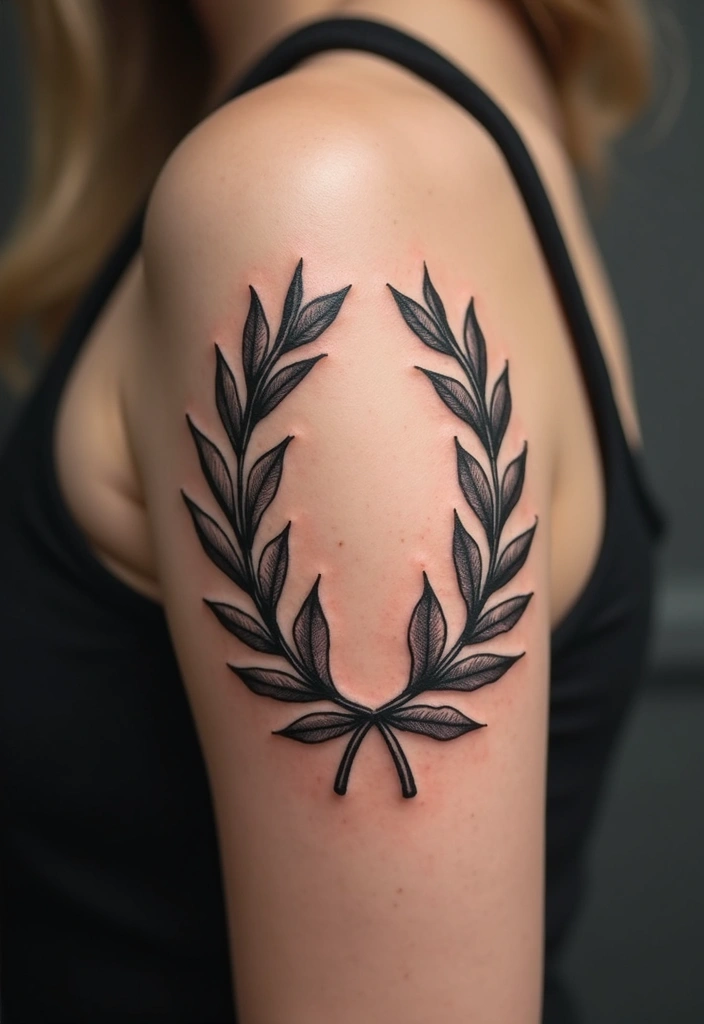
What you’re chasing
You want a tattoo that marks a big win. The laurel, or Gekkeiju, fits that need. It signals victory and steady work. In Yakuza style, a Gekkeiju tattoo honors goals you chased and earned.
Meaning and look
A laurel crown can wrap around a name, a date, or a badge. Leaves bend with your body and can be drawn in many ways. Thin lines give a delicate touch; bold leaves feel classic. Subtle shading makes the leaves look alive on skin.
Where and how to wear it
Place matters. The forearm, upper arm, chest, or shoulder blade work well. A small piece can honor one achievement. A larger one can tell a longer story of your journey. Pick a size that fits your life.
Practical steps to begin
Ask for clean line work if you want lasting results. Black ink stays crisp longer. Dark greens add life without shouting color. Talk about aging and touch ups with your artist. Bring leaf shapes you like from pictures.
– Represents victory and accomplishment
– Often uses detailed laurel leaves
– Great for marking personal wins
– Works with script or other symbols
Next steps Take your time and plan ahead to get a laurel tattoo that fits you.
24. 生命 (Inochi) – Life
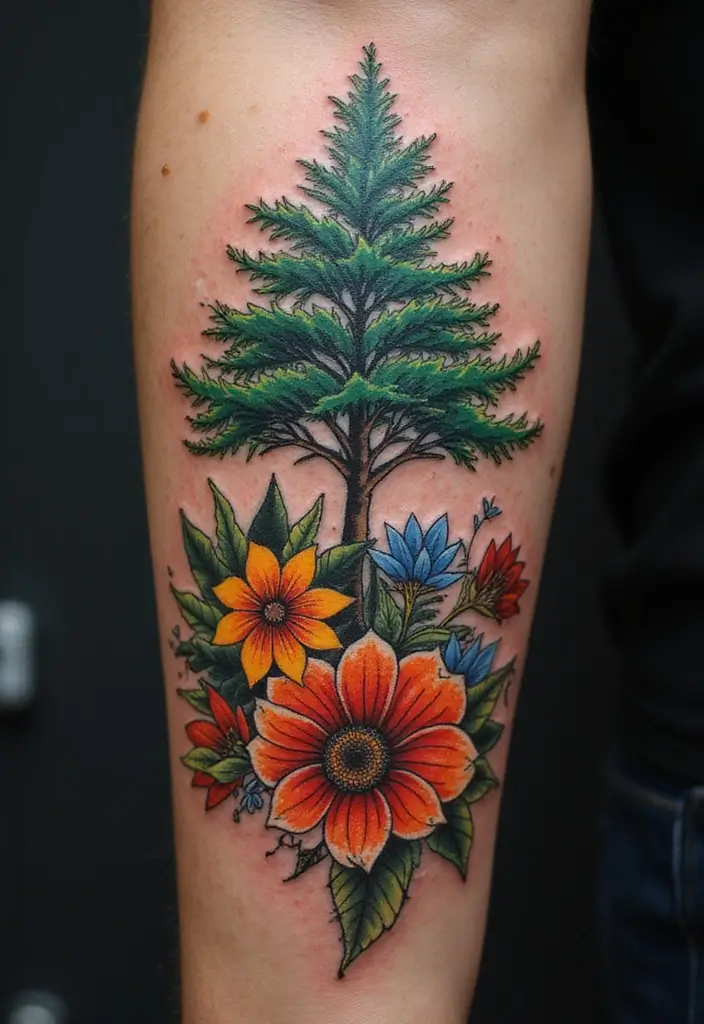
Inochi means life. It captures the core of your being. When you choose an Inochi tattoo, you show the energy that keeps you moving. Life is a long story.
In Yakuza tattoos, Inochi is drawn with nature. Flowers, trees, rivers, and wind show life grows and changes. The design weaves spring buds with old branches and fast streams with calm pools, showing life cycles. You can use color or black ink to tell the story.
Here is how to make it work for you:
– Represent the essence of existence with simple lines that flow.
– Use natural motifs such as blossoms, leaves, or a growing tree.
– Place it where your body flows, like the arm, chest, or back.
– Choose a style you love: bold blackwork or soft watercolor.
– Add a personal touch, like a favorite flower or a season that marks a moment.
Practical tips:
– Talk with your artist about size, shading, and ink depth.
– Try a small preview first to see how the design ages on your skin.
– Consider a color splash in a limited area for a modern touch.
– Expect the art to evolve as you do.
Let the design grow with you. Start small and let details mature over time. Inochi invites you to honor life’s journey every day.
Inochi, meaning life, reminds us that every tattoo tells a story. Embrace the cycles of growth and change, and let your design reflect the vibrant energy that fuels your journey!
25. 祝福 (Shukufuku) – Blessing
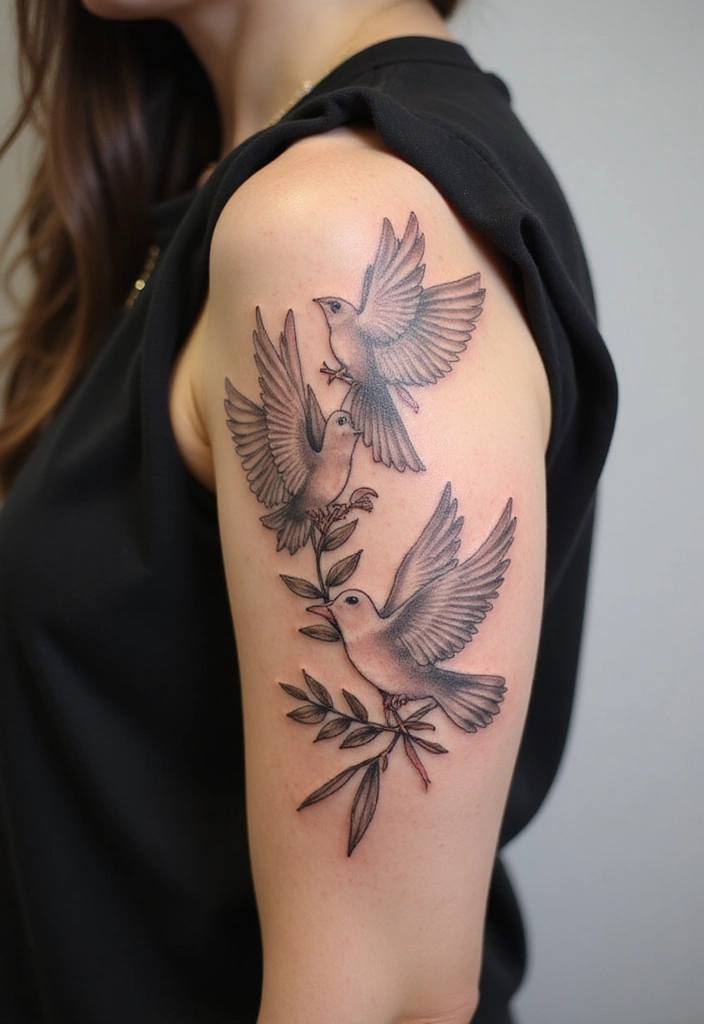
Shukufuku means a blessing and good energy. You wear this mark to invite luck, joy, and calm. In Yakuza art, the Shukufuku design centers on blessing symbols and a peaceful feel.
Common symbols
– Doves mean purity; olive branches mean peace.
– The look stays detailed but restrained.
Think of it as a quiet reminder to stay grateful.
To blend it with a full sleeve or chest piece, keep the lines smooth and let colors stay subtle. It should feel like a calm breath in your art.
How to design it
– Pick a symbol you relate to, like a dove or olive branch.
– Choose boldness. A clean black line with soft shading lasts; a hint of color can add meaning.
– Place it where it breathes. The shoulder, chest edge, or forearm work well.
Practical steps
– Work with an artist familiar with Irezumi or Japanese styles.
– Start with a simple outline, then add gentle shading.
– Ask for a small test patch to check ink density.
Care and longevity
– Keep the area clean during healing and moisturize as directed.
– A well done Shukufuku ages gracefully and keeps its calm message.
Next steps
– Decide the exact blessing you want to carry.
– Bring symbol ideas to your artist and see how they fit with your other work.
Trust the process and talk openly with your artist.
26. 夢 (Yume) – Dreams
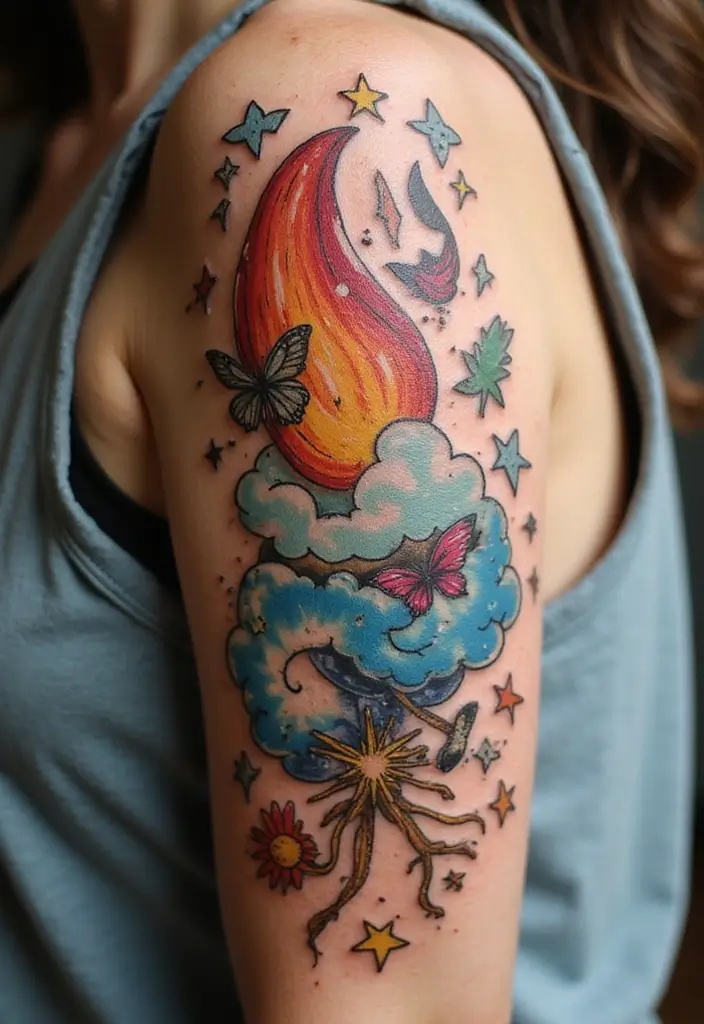
If you want a tattoo that keeps you aiming for your goals, Yume fits you. 夢 means dreams and what you hope to reach. In Yakuza tattoo designs, Yume shows your hopes and plans. The look can be soft and dreamy or bold and symbolic. You might see stars, the moon, clouds, or small dream symbols woven into the design. This symbol helps you stay focused on the future and the steps you will take.
What Yume Means for You
– Represents dreams and aspirations in plain terms.
– Often designed with light, flowing lines or clear, meaningful motifs.
– Great for people who want a daily nudge to pursue their goals.
– Pairs well with other motifs like koi, cranes, or wind elements.
Turning Dream Symbols into Real Tattoos
Here is why Yume works in real life. Let’s break it down into practical steps you can use.
– Decide on your personal dream. Write it down in one sentence and pick a symbol that fits it.
– Pick a style. Do you want soft, wispy lines or sharp, strong shapes? A traditional Japanese look uses thick ink and bold shading.
– Choose color or keep it classic. Black and gray gives a timeless feel. A touch of blue or gold can add mood for a night scene.
– Plan placement. Forearm and shoulder spots work well for a single piece, while the back or chest fits a larger scene.
– Find the right artist. Look for someone who can do clean lines and smooth shading. Review their work before you commit.
Next steps: talk to a tattoo shop, see sketch options, and adjust until Yume mirrors your dream.
27. 運命 (Unmei) – Destiny
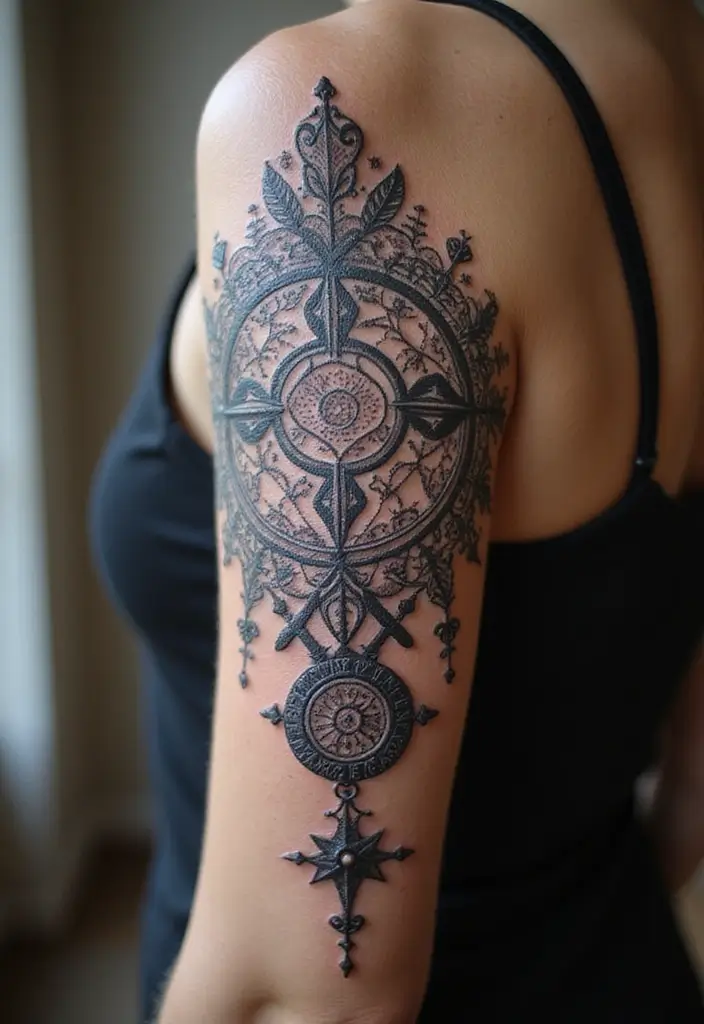
Unmei – Destiny
Are you looking for a tattoo that marks your life path? Unmei, written as 運命, stands for destiny. In Yakuza ink, this symbol says your story is shaped by the choices you make. You wear a map of your journey on your skin. An Unmei design can use lines or patterns to trace the route from start to now.
Here is why this symbol works: it stays meaningful over time and fits with other signs.
– Represents destiny and the journey of life.
– Uses winding lines to show roads, crossroads, and turning points.
– Fits well on the arm, shoulder, or back as a focal point.
– Reminds you that each choice shapes your path.
Next, how to tailor it to your style. Choose a style that keeps the meaning clear, using black ink for a bold punch or color accents to highlight turning points. Pair Unmei with a companion symbol like a compass, blossom, or crescent moon to add depth. Talk with your artist about line weight, shading, and placement.
Let’s break it down: ask to see sketches that show a simple road and a complex maze version.
Next steps: bring ideas, set a size, and review after stencil is drawn.
28. 理想 (Risou) – Ideal
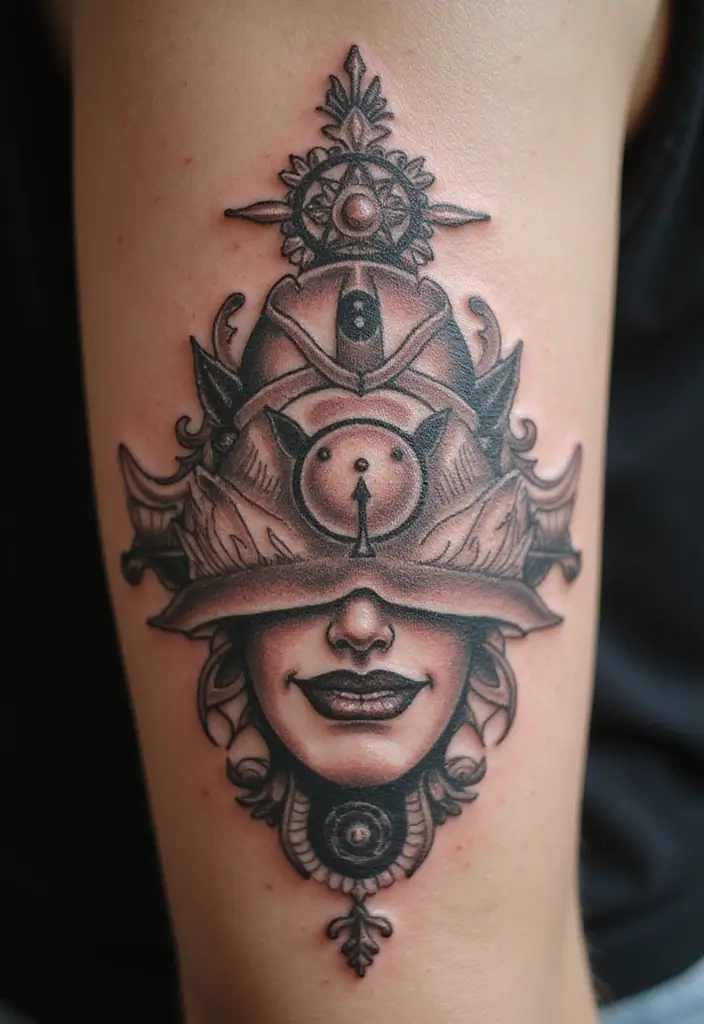
What Risou means for you
You want a tattoo that keeps you focused on big goals. Risou means ideal. It marks your path and stays with you. It’s a daily nudge to chase your best self.
Here is why it helps. It blends personal dreams with ink you can wear every day. It stays with you through good days and hard ones. It shows your drive to grow and move forward.
What to include in a Risou design
– Compass for direction toward your dreams
– Star for a clear goal you want to reach
– Mountain for the climb and work ahead
– Lantern for guidance in dark times
– Script of Risou in kanji or letters for a personal touch
Next steps to plan your Risou tattoo.
– Reflect on your top goals and pick two or three symbols
– Decide where it will sit on your body
– Talk with a tattoo artist about style (Japanese, blackwork, or color)
– Plan simple aftercare to keep the ink bright
Where it tends to go
A Risou piece works well on the chest, shoulder, upper arm, or back. It can be small or bold, depending on your feel.
Care for a lasting look
Choose bold lines and keep color simple. Follow aftercare steps. Stay out of direct sun while it heals. Schedule a touch-up if the lines fade.
29. 過去 (Kako) – The Past
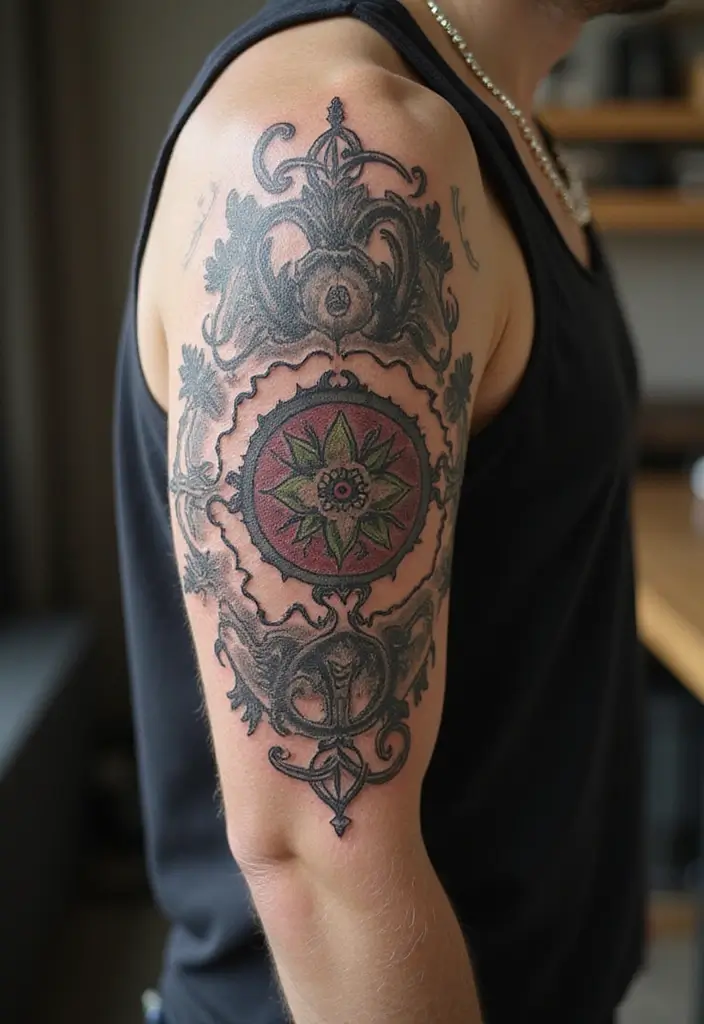
If you want a tattoo that marks your past, Kako is a strong choice. Kako stands for the past and the lessons you carry. In Yakuza tattoos, this design shows you value history. It is not a badge of regret. It serves as a map of who you were and who you are becoming.
Here is why it works for you. You can add elements that reflect your journey. A faded photo, a worn road sign, a date in kanji, or a memory in muted color. A simple compass can point to your next step. Keep the design balanced. Pair a single symbol with small scenes that tell a clear story.
Next steps to plan your Kako tattoo:
– Reflect on the lessons you learned.
– Choose 2 to 4 motifs that mark key moments.
– Think about placement on the arm, back, or chest and how the eye moves through the design.
– Decide on black ink for a classic look or a soft color that mirrors a memory.
The result is a reminder you can carry. A Kako tattoo helps you stay true to your path and honors your roots while you grow. It can be bold or subtle, depending on what you want to say.
Tips for working with your artist:
– Share the meaning and the story behind each element.
– Ask for panel layouts that fit your body.
Let the ink age well with careful shading and clean lines. Take your time. Your tattoo should feel right years from now.
30. 未来 (Mirai) – The Future
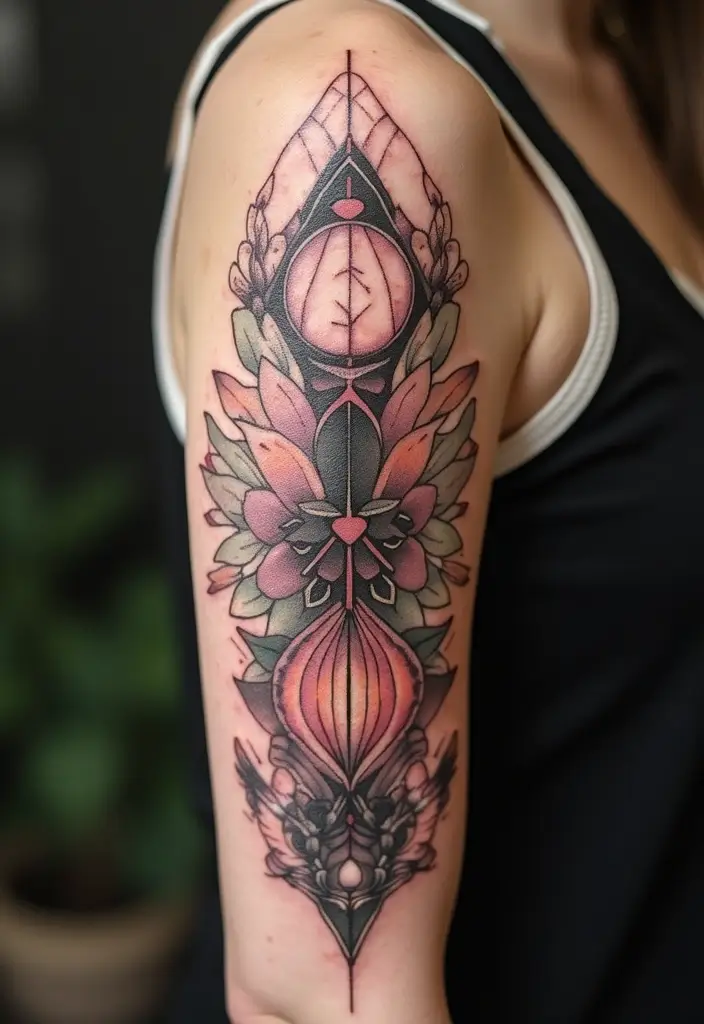
You’re after a tattoo that points to what comes next. Mirai, written as 未来, stands for the future and the road you’ll walk. Here is why this symbol fits a Yakuza tattoo: it blends steady hope with a clear sense of direction.
In design, Mirai often shows light on the horizon, rising suns, or lines that move forward. You can pair it with dream motifs like distant peaks, compass needles, or a subtle path that leads your eye ahead. Keep the lines clean and bold, so the message stays strong even when the ink ages.
Here are practical ways to make Mirai work for you:
– Represent the future and all the paths you could take
– Add elements that symbolize dreams or goals, like mountains, stars, or a directional arrow
– Use a calm, confident look with black ink and smooth shading
– Keep the design balanced with surrounding Yakuza style details, such as cloud wisps or waves
Next steps for the best result: talk with your tattoo artist about the exact kanji form, size, and placement. A well-placed Mirai piece can grow with you as your plans unfold. Be honest about what the future means to you, and let that meaning guide the final look.
Conclusion
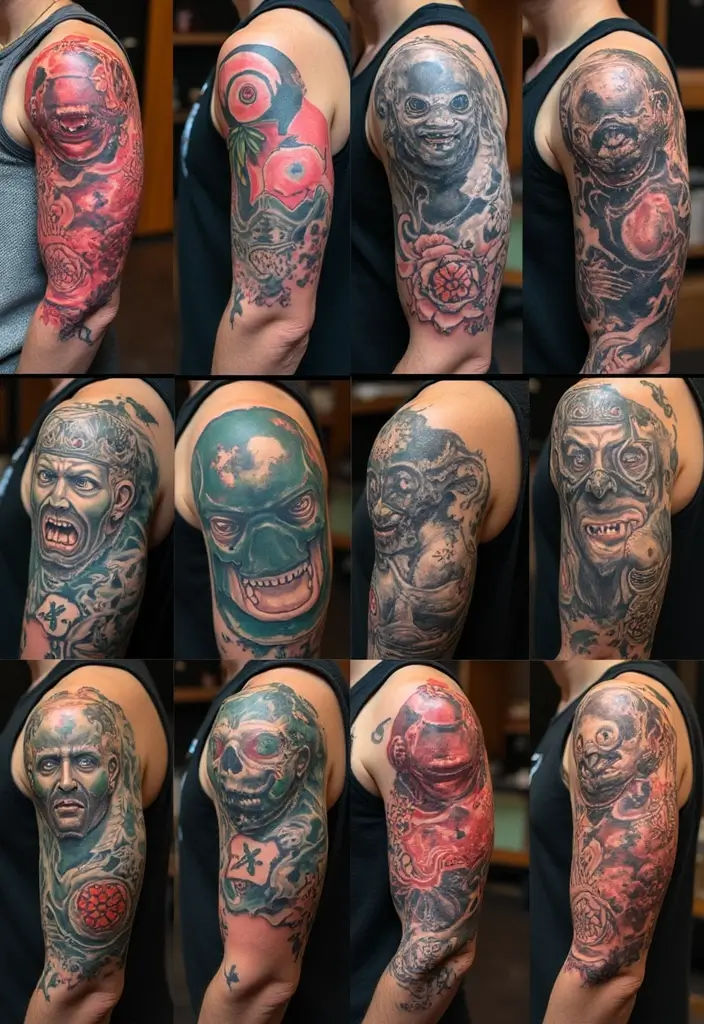
The world of Yakuza tattoos offers a rich tapestry of symbols and meanings, reflecting deep cultural significance and personal journeys. Each tattoo name holds a story, echoing the beauty of Japanese culture intertwined with the wearer’s own life experiences. As you consider your next tattoo, remember that every design can be a powerful statement of who you are and the paths you’ve traveled.
Whether you choose a dragon for strength or a crane for peace, let each tattoo resonate with your unique journey and identity.
Frequently Asked Questions
What Are Some Popular Yakuza Tattoo Names and Their Meanings?
Yakuza tattoos are deeply rooted in Japanese culture, with names like Ryuu (Dragon), symbolizing strength and protection, and Tsuru (Crane), representing longevity and good fortune. Each name carries a significant meaning that connects to personal stories or cultural beliefs.
For example, Koi (Koi Fish) signifies perseverance, while Hannya (Hannya Mask) embodies deep emotions and transformation.
How Do I Choose the Right Yakuza Tattoo Name for My Design?
Choosing the right Yakuza tattoo name involves reflecting on what resonates with you personally. Consider what you want your tattoo to symbolize—whether it’s strength, protection, or love. Research different names and their meanings to find one that aligns with your life experiences or aspirations.
Don’t hesitate to consult with a tattoo artist who specializes in traditional Japanese tattoos; they can offer valuable insights and suggestions for your design.
Are Yakuza Tattoos Only for Yakuza Members?
While Yakuza tattoos are often associated with members of the Yakuza, many people outside this culture appreciate their beauty and symbolism. These tattoos can serve as a form of self-expression and storytelling.
However, it’s important to be respectful of the cultural significance behind these designs. Understanding the meanings behind Yakuza tattoo names will help you honor their origins, regardless of your personal connection to Yakuza culture.
What Should I Know About the Tattooing Process for Yakuza Tattoos?
The tattooing process for Yakuza tattoos can vary widely, but traditional styles often involve hand-poked techniques, which are meticulous and require a skilled artist. It’s essential to choose an experienced tattoo artist who understands Japanese tattoo meanings and can accurately depict the symbolism you desire.
Additionally, prepare for the healing process, as traditional tattoos may take longer to heal than modern machine-made tattoos.
Can I Customize My Yakuza Tattoo Design?
Absolutely! Customizing your Yakuza tattoo design is a great way to make it uniquely yours. You can combine elements from different Yakuza tattoo designs to create a piece that reflects your personality and story. Share your ideas and inspirations with your tattoo artist, who can help you merge traditional symbols with your personal vision.
Just remember to stay true to the cultural significance of the symbols you choose!

